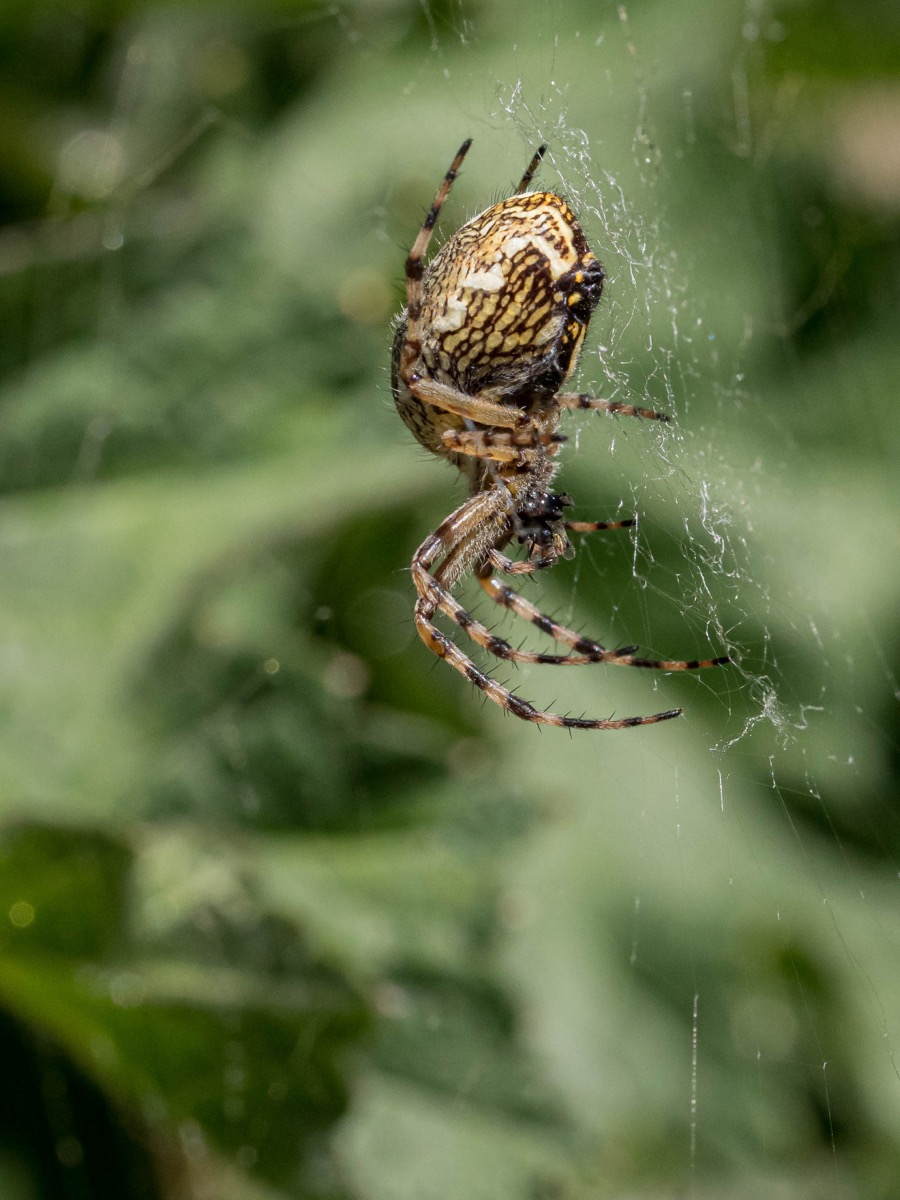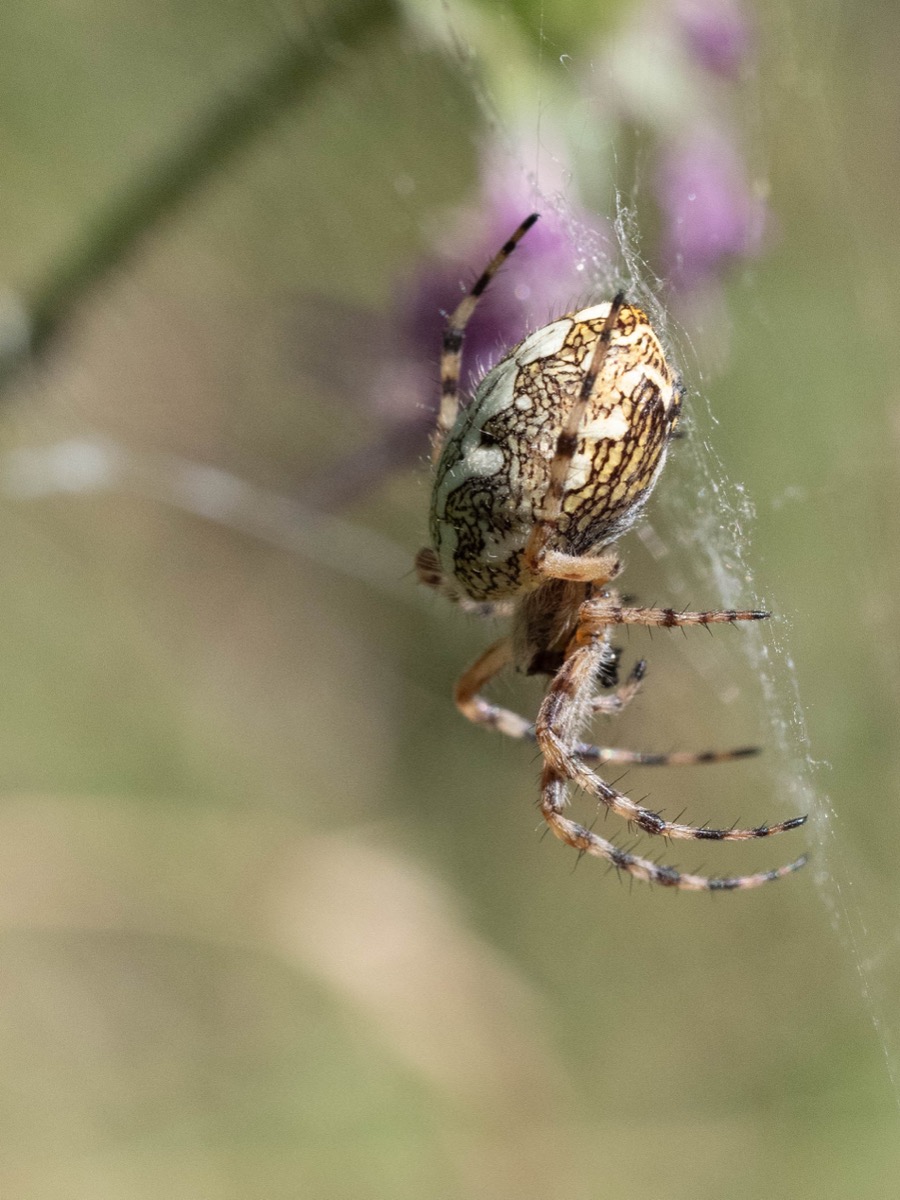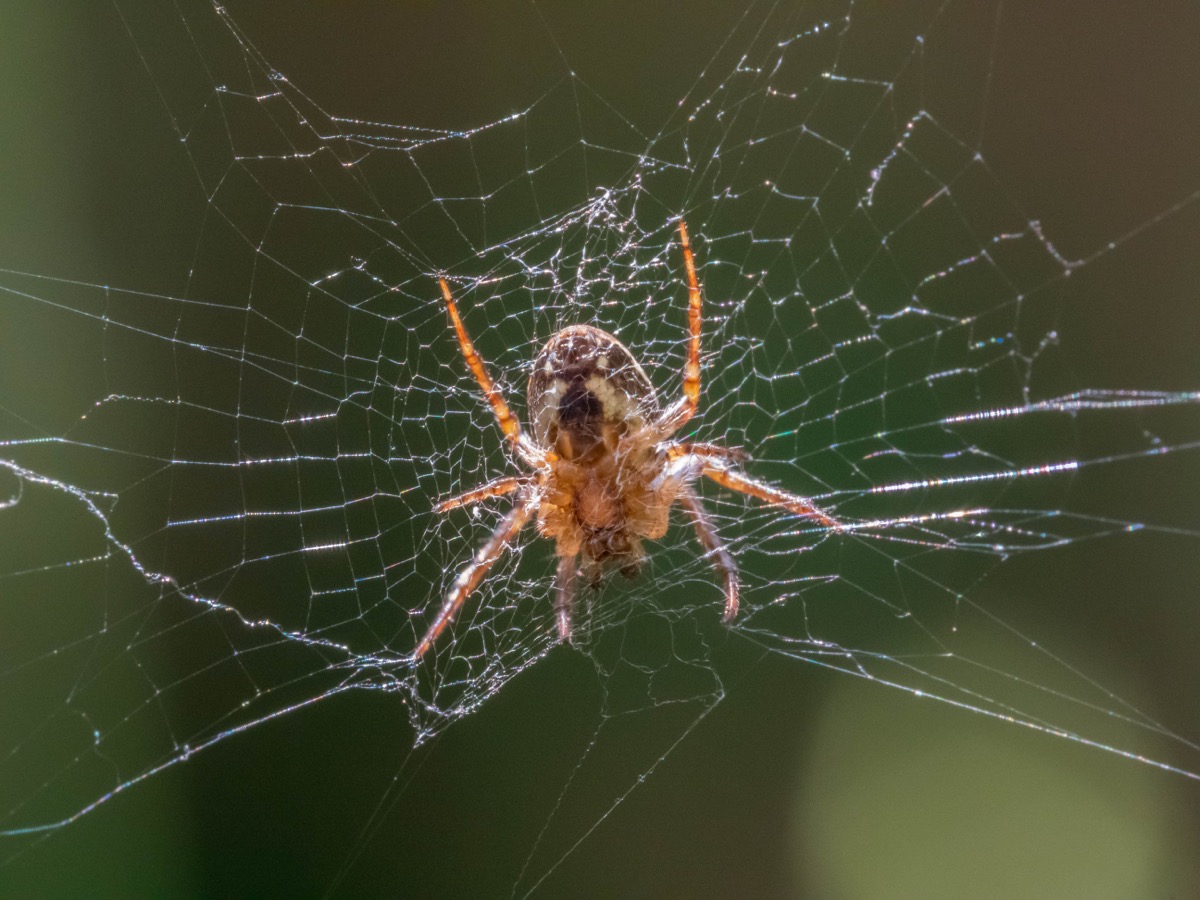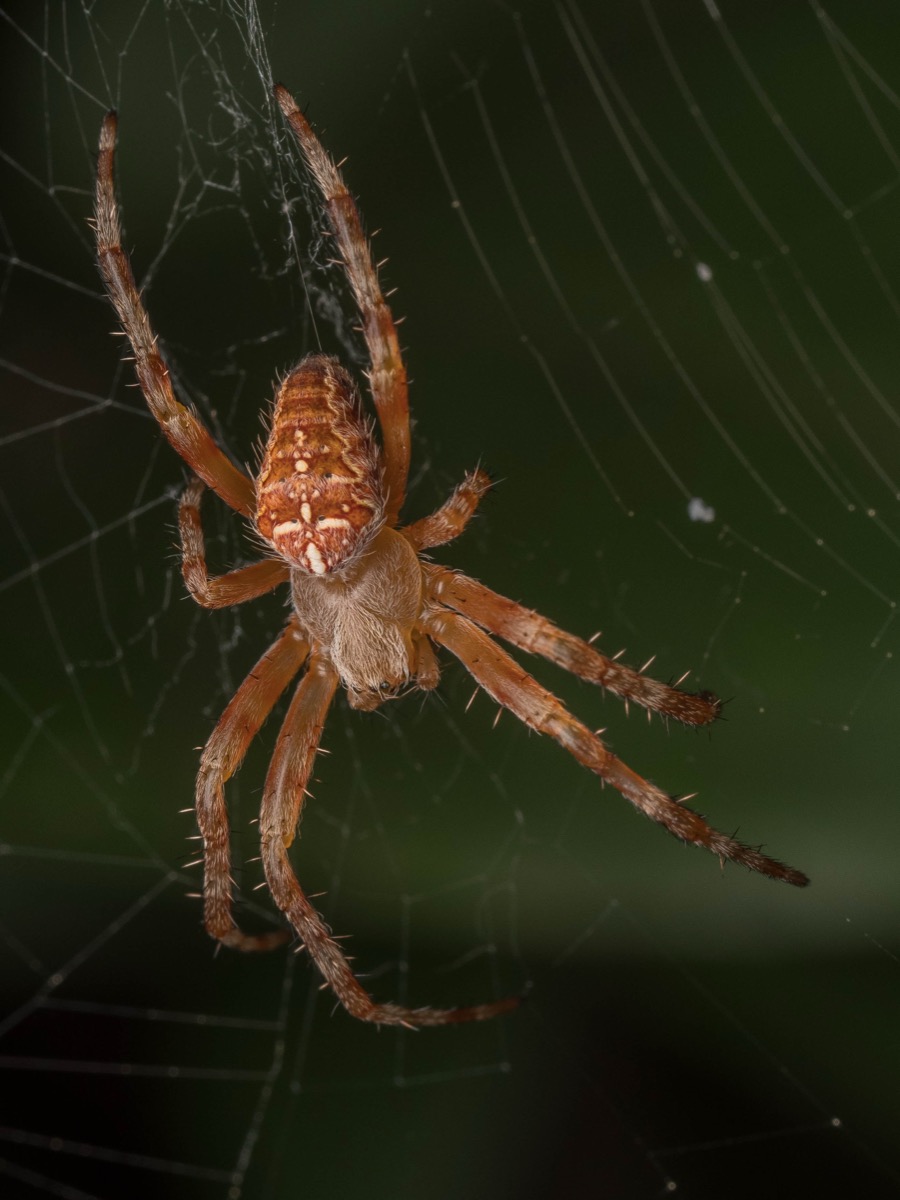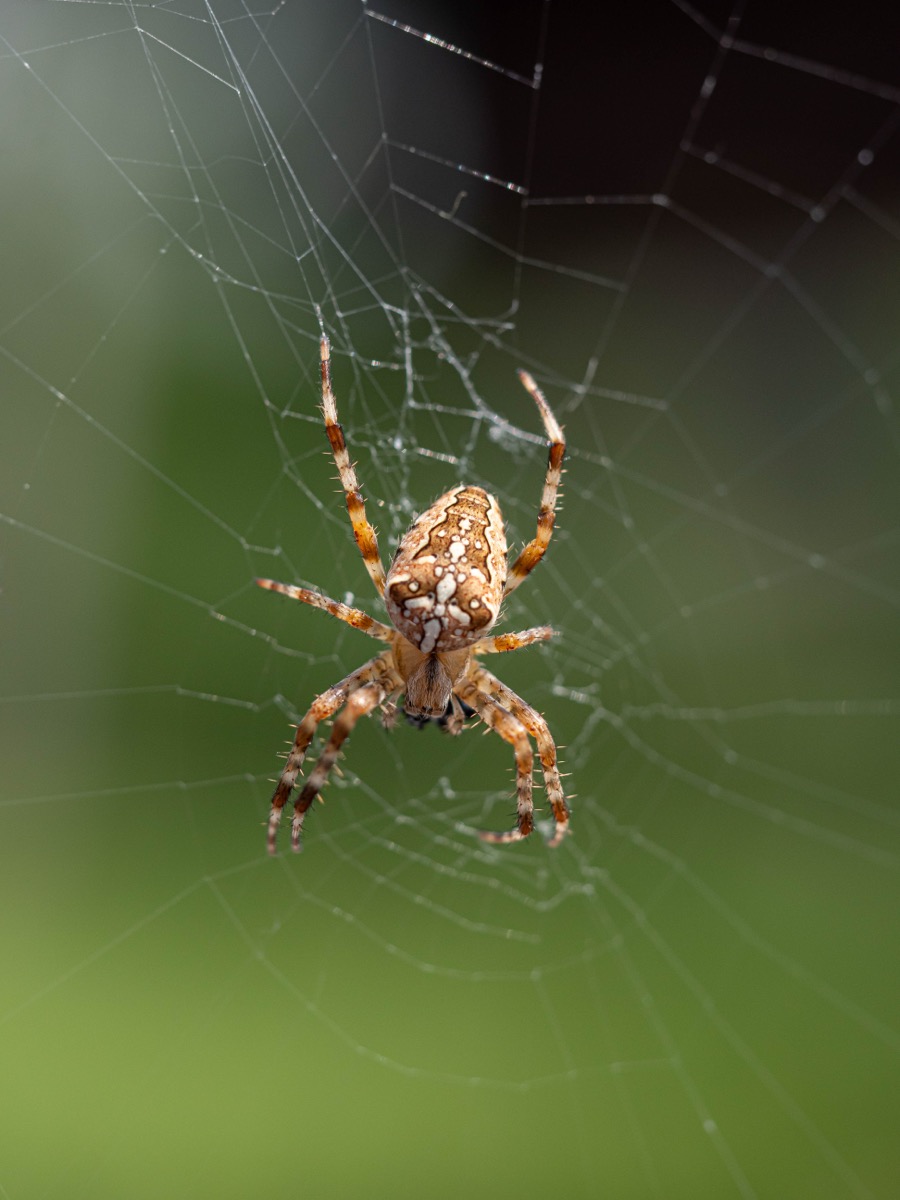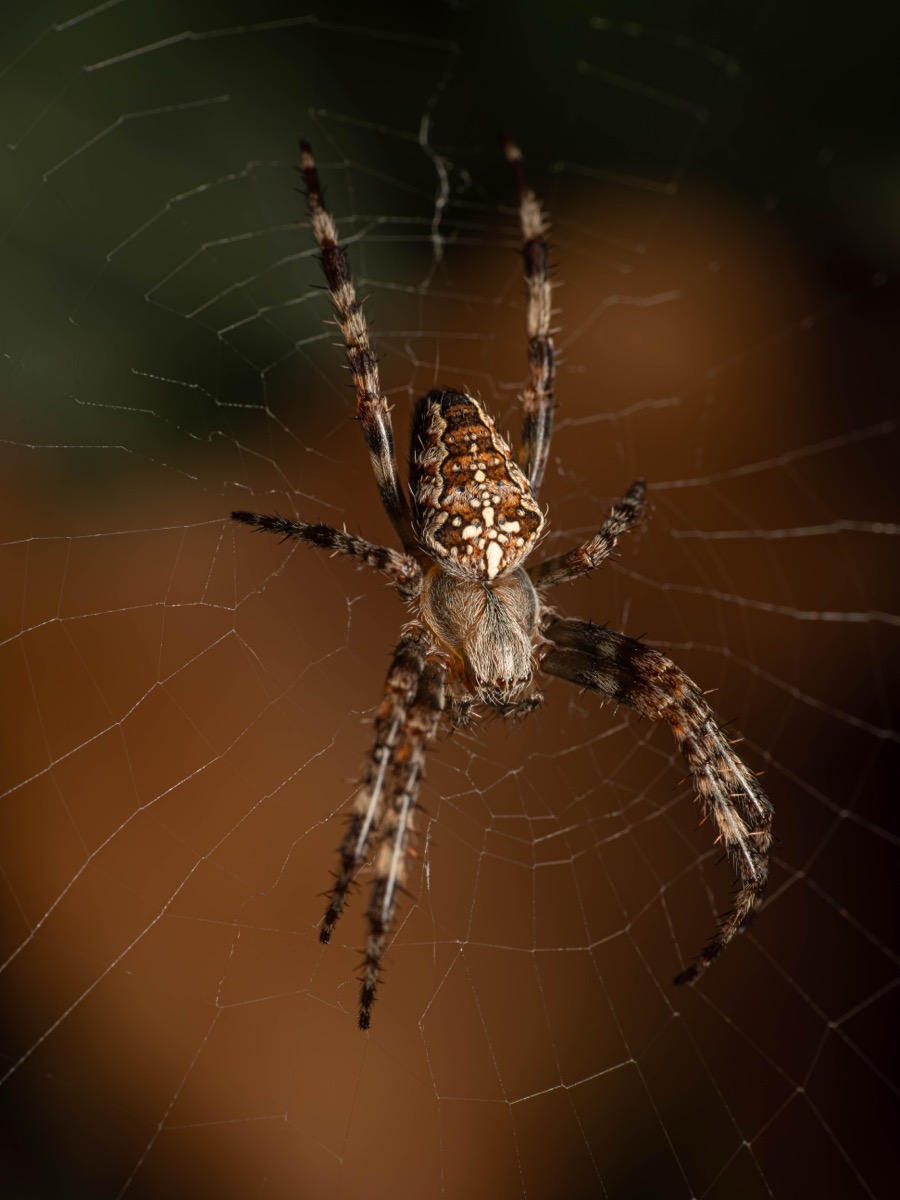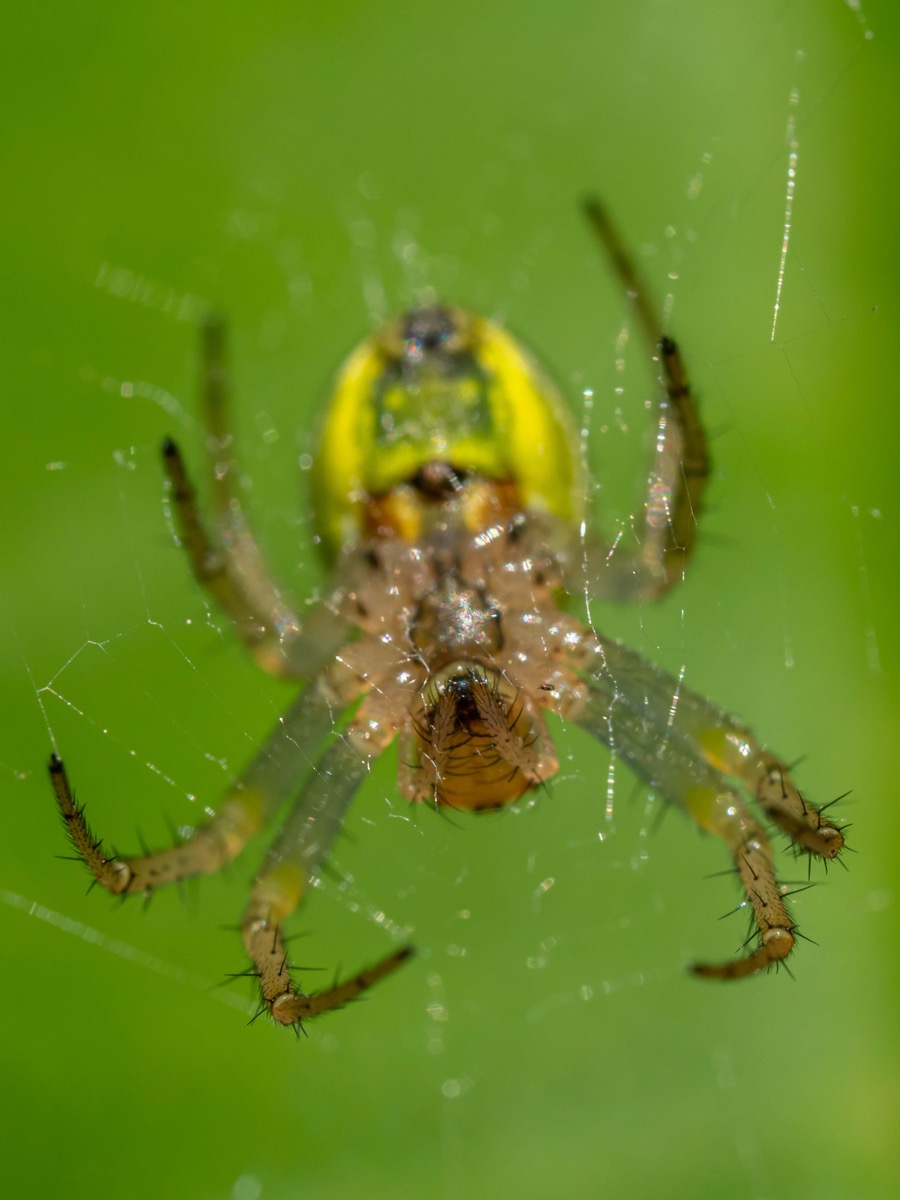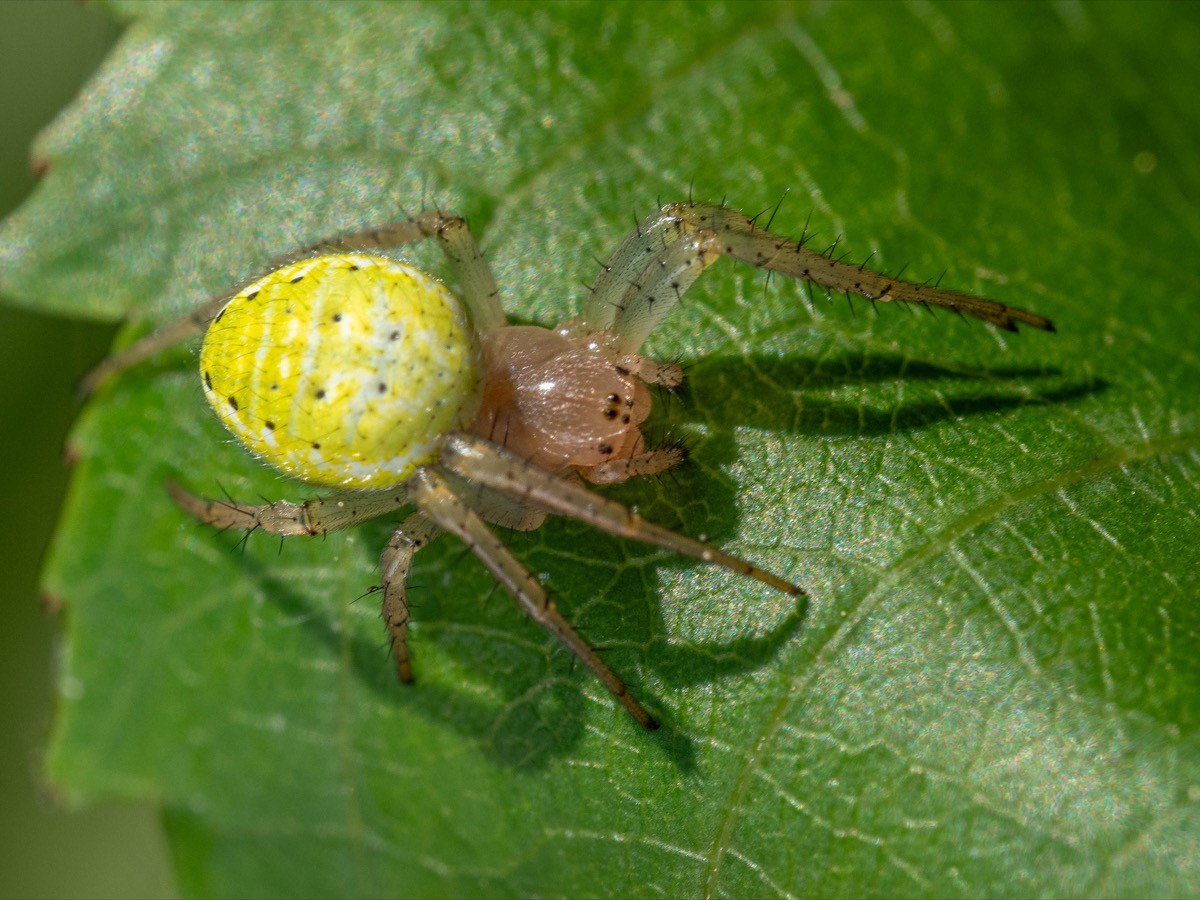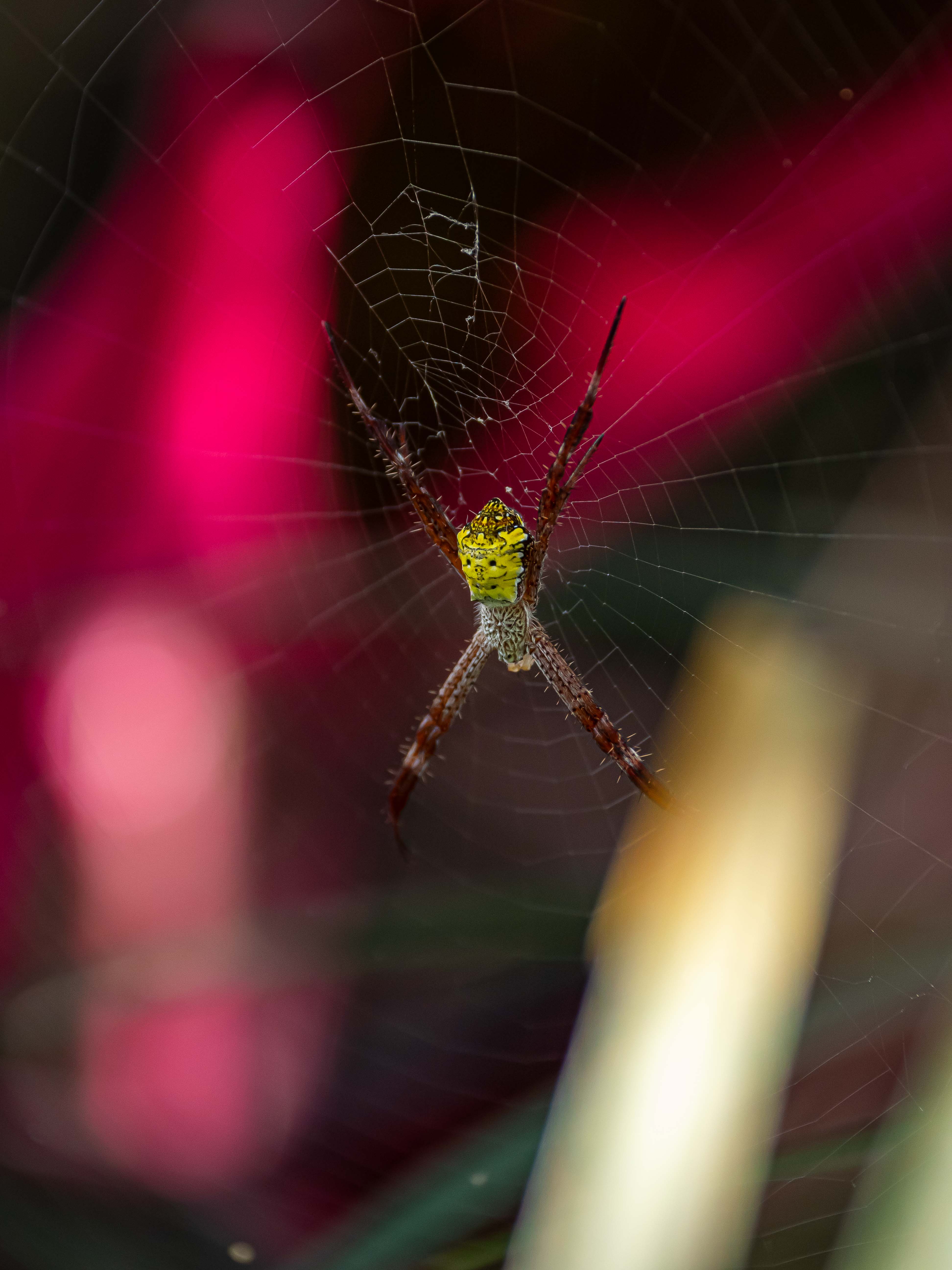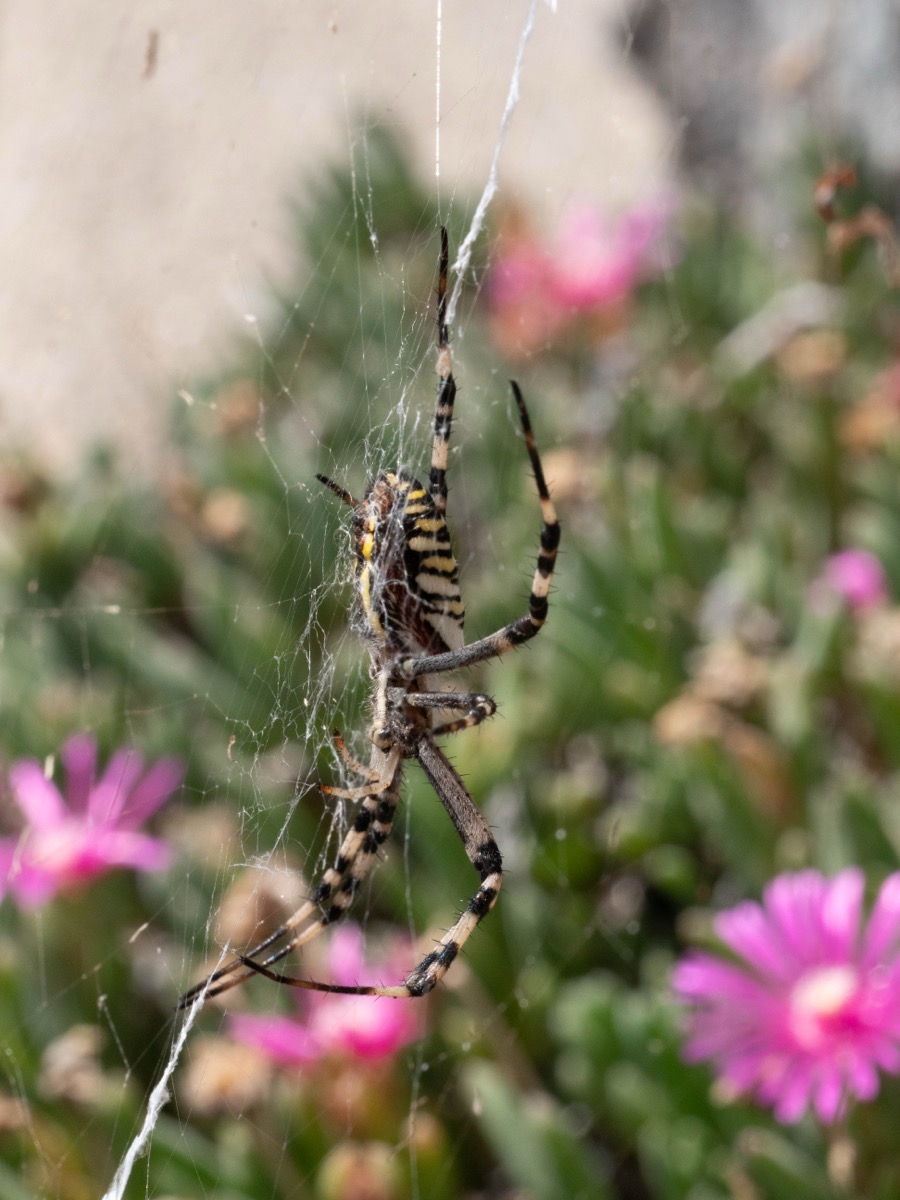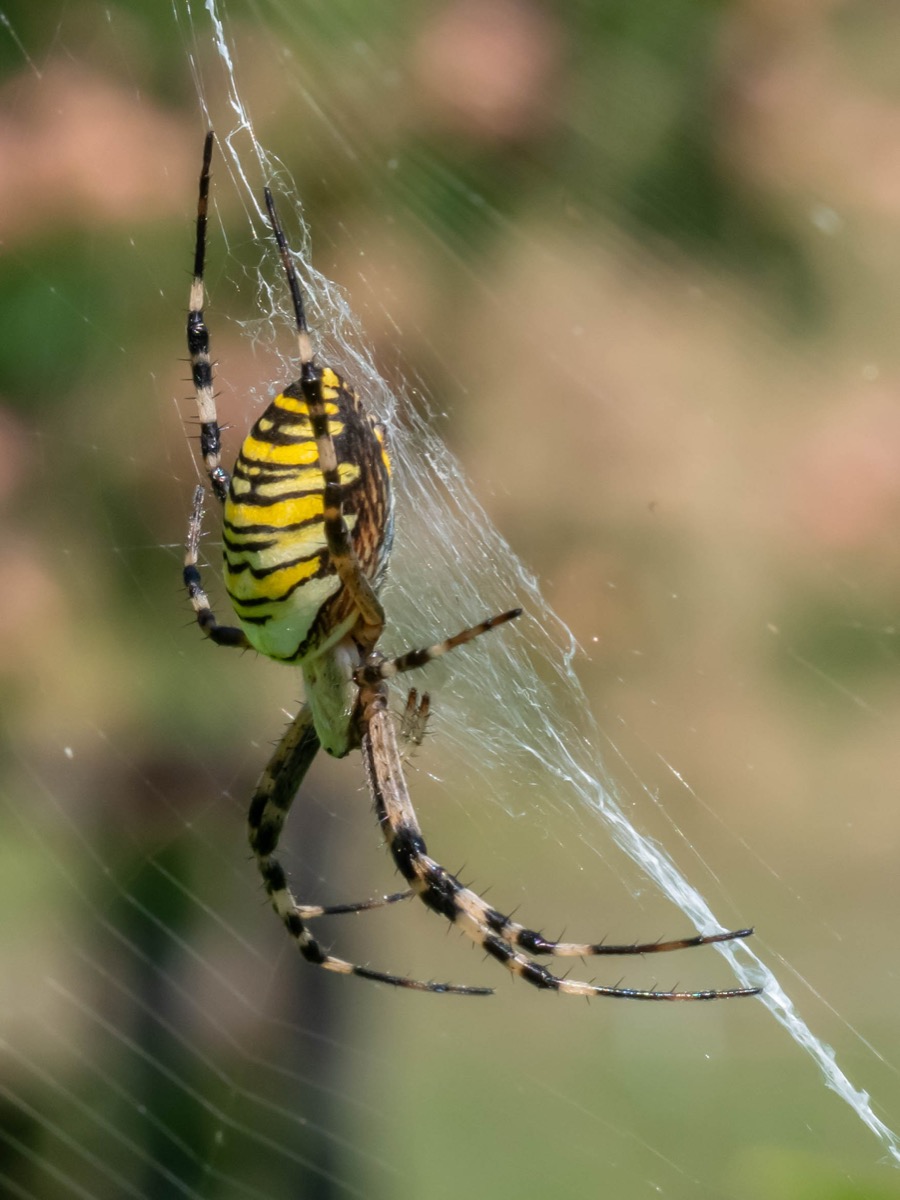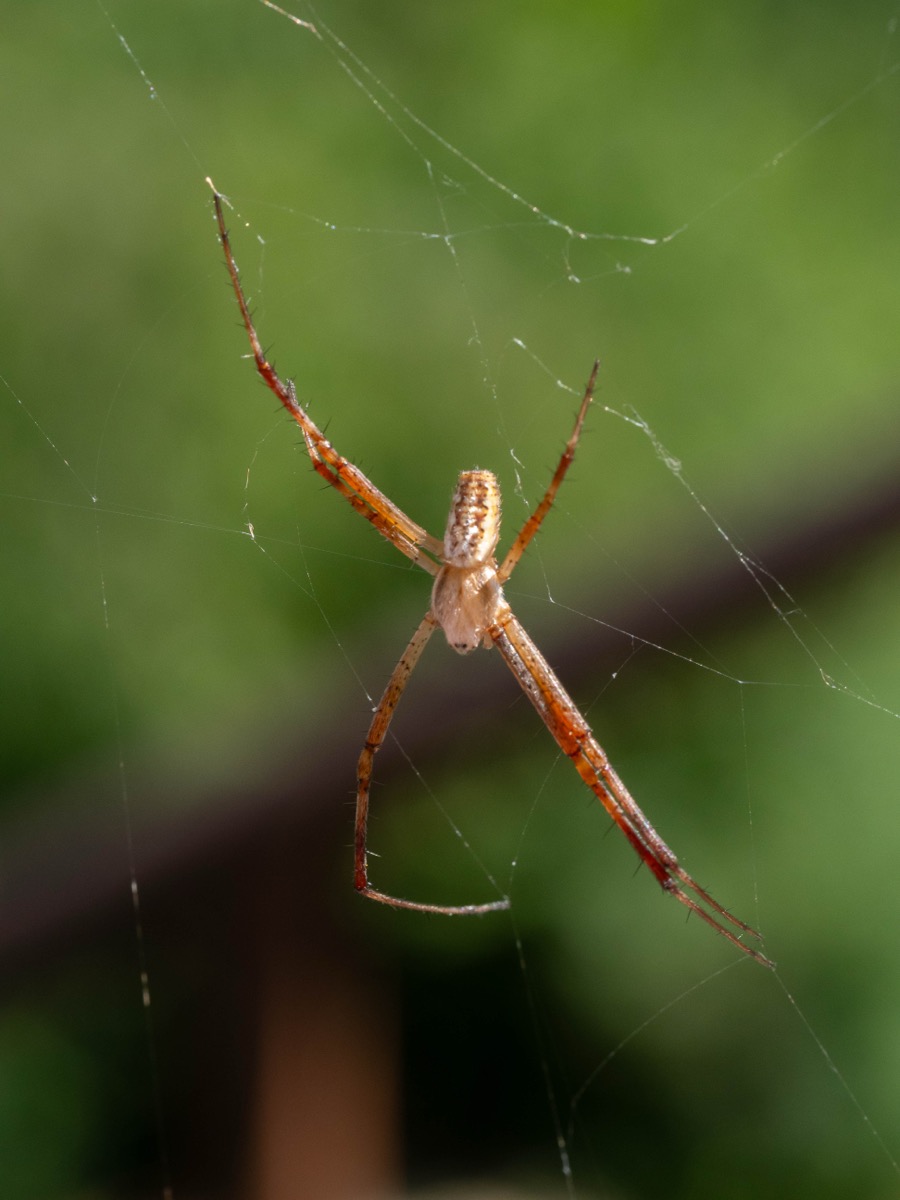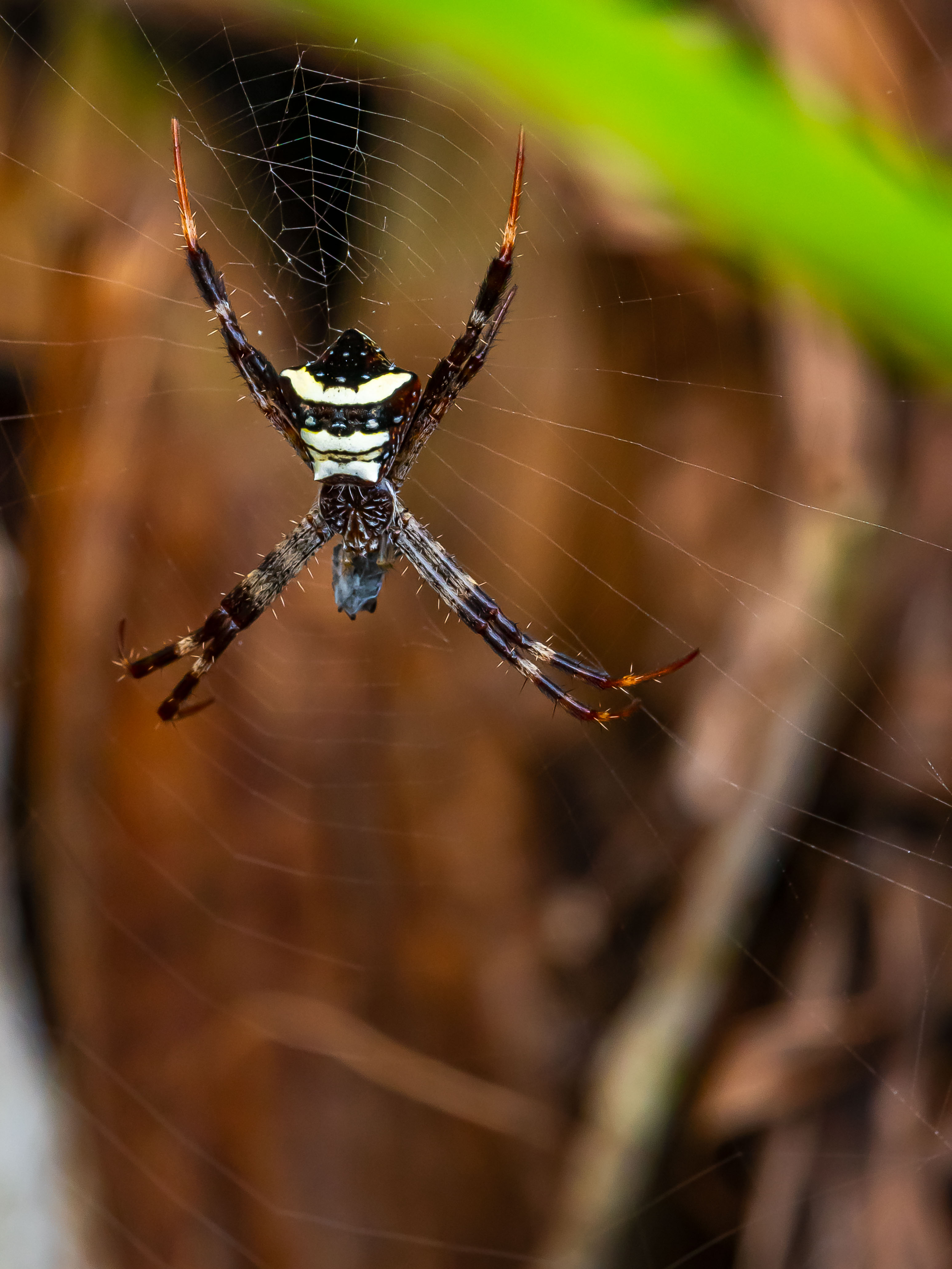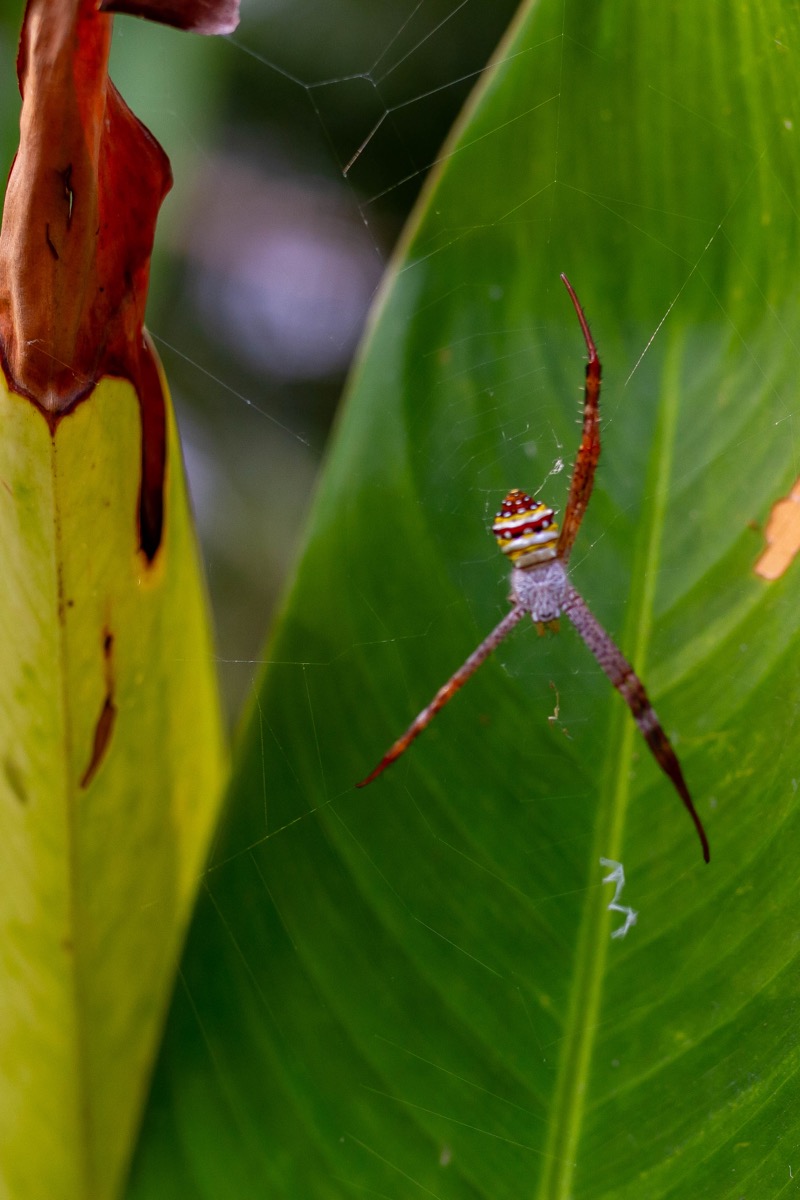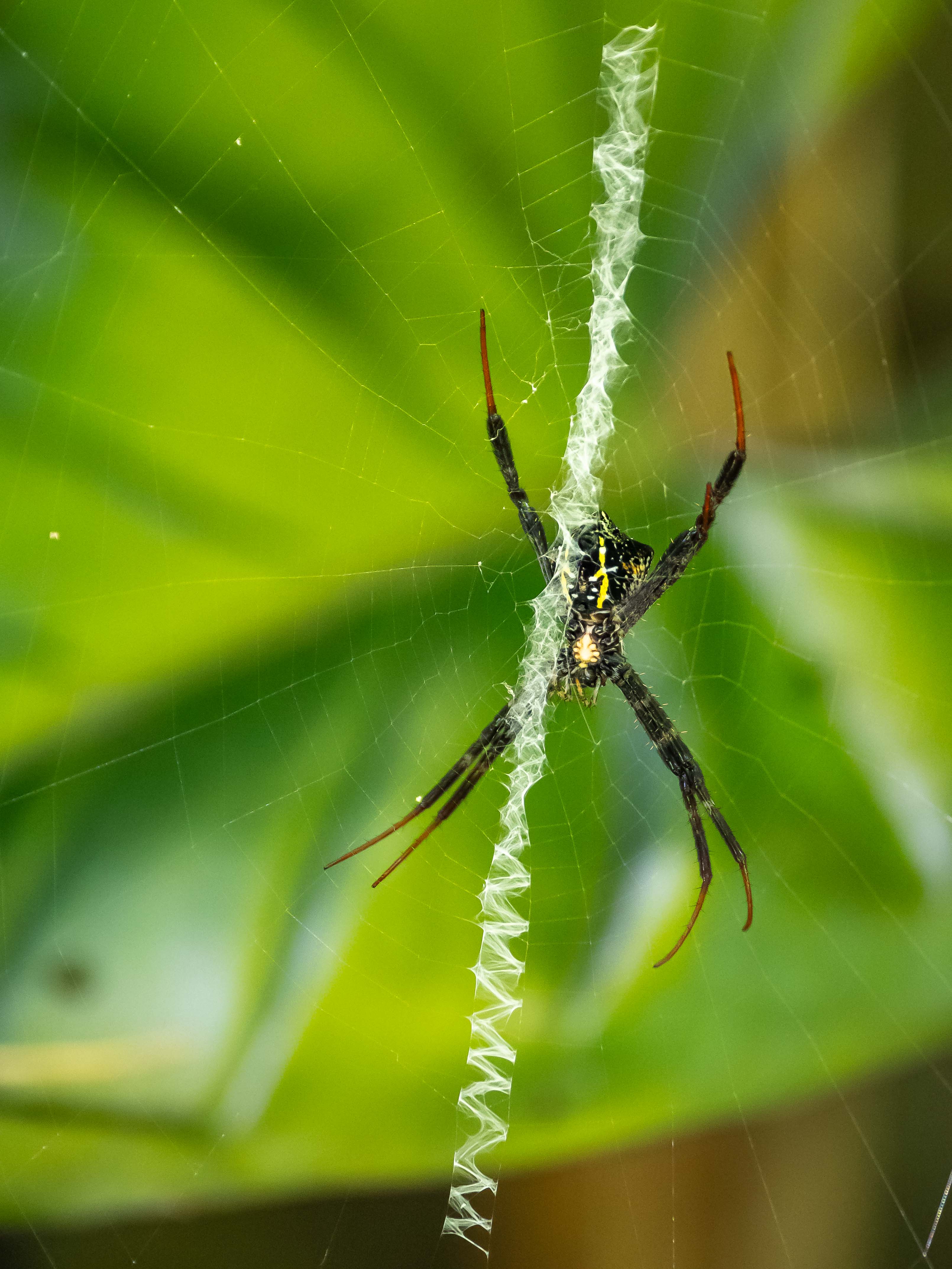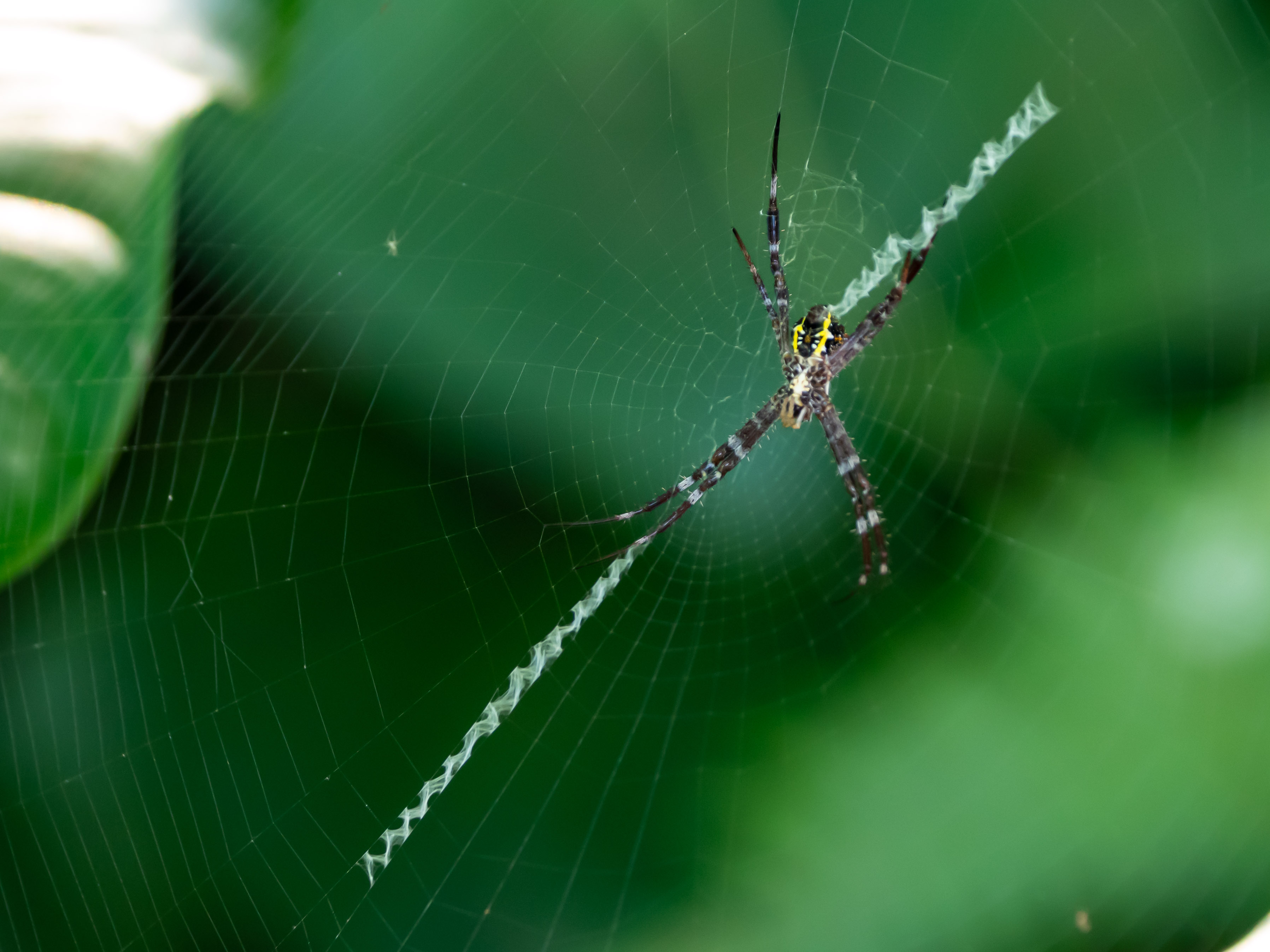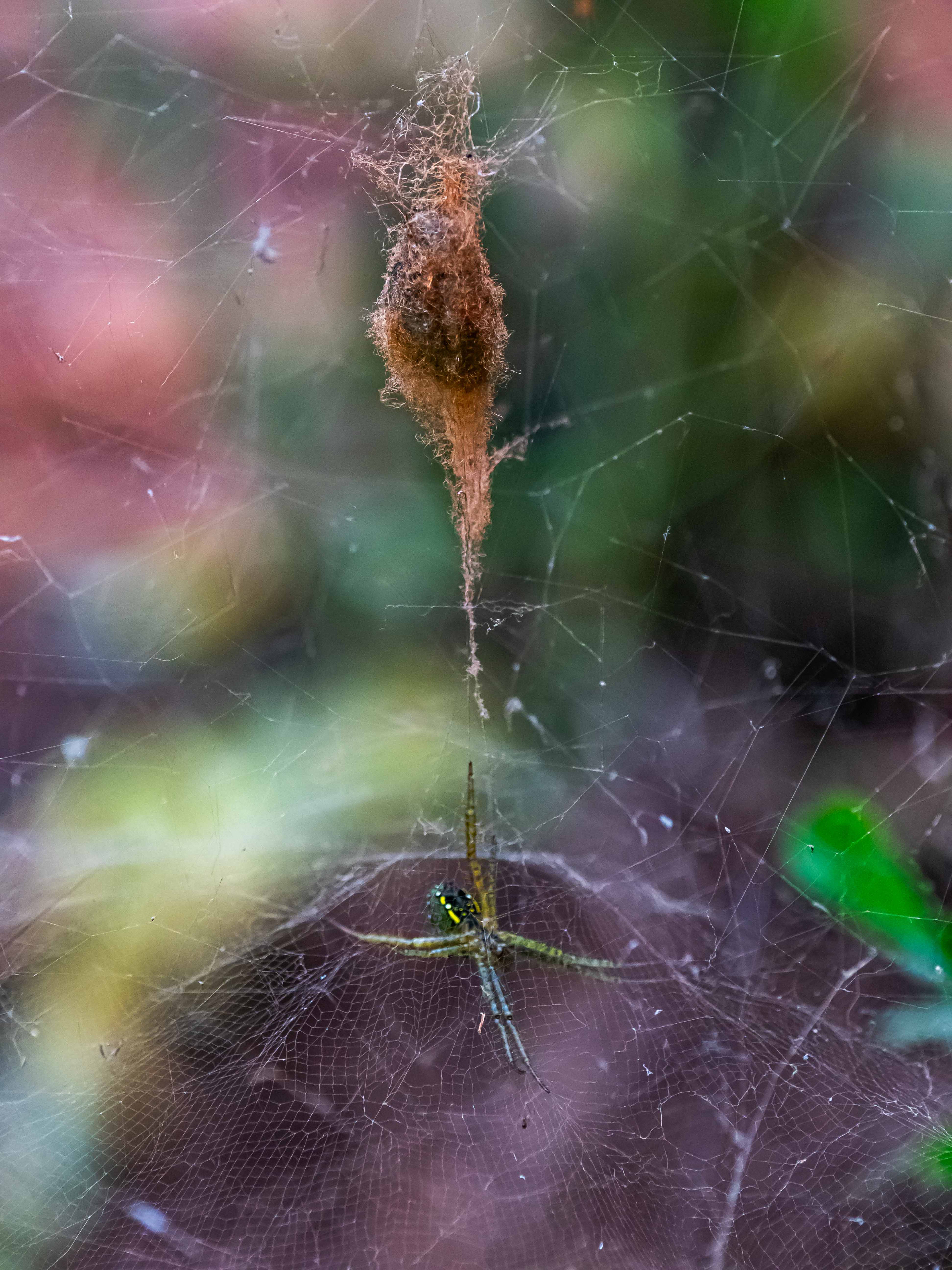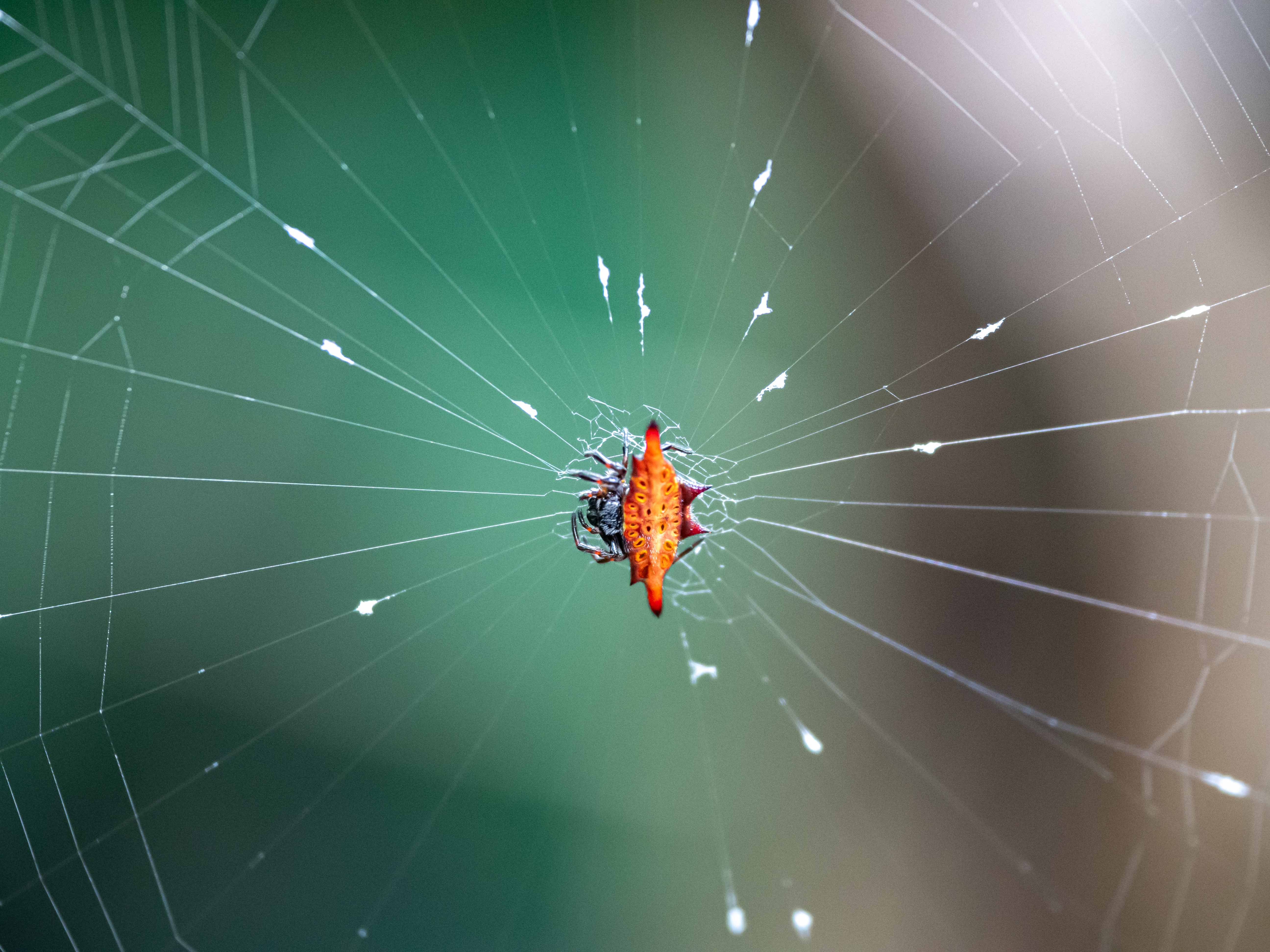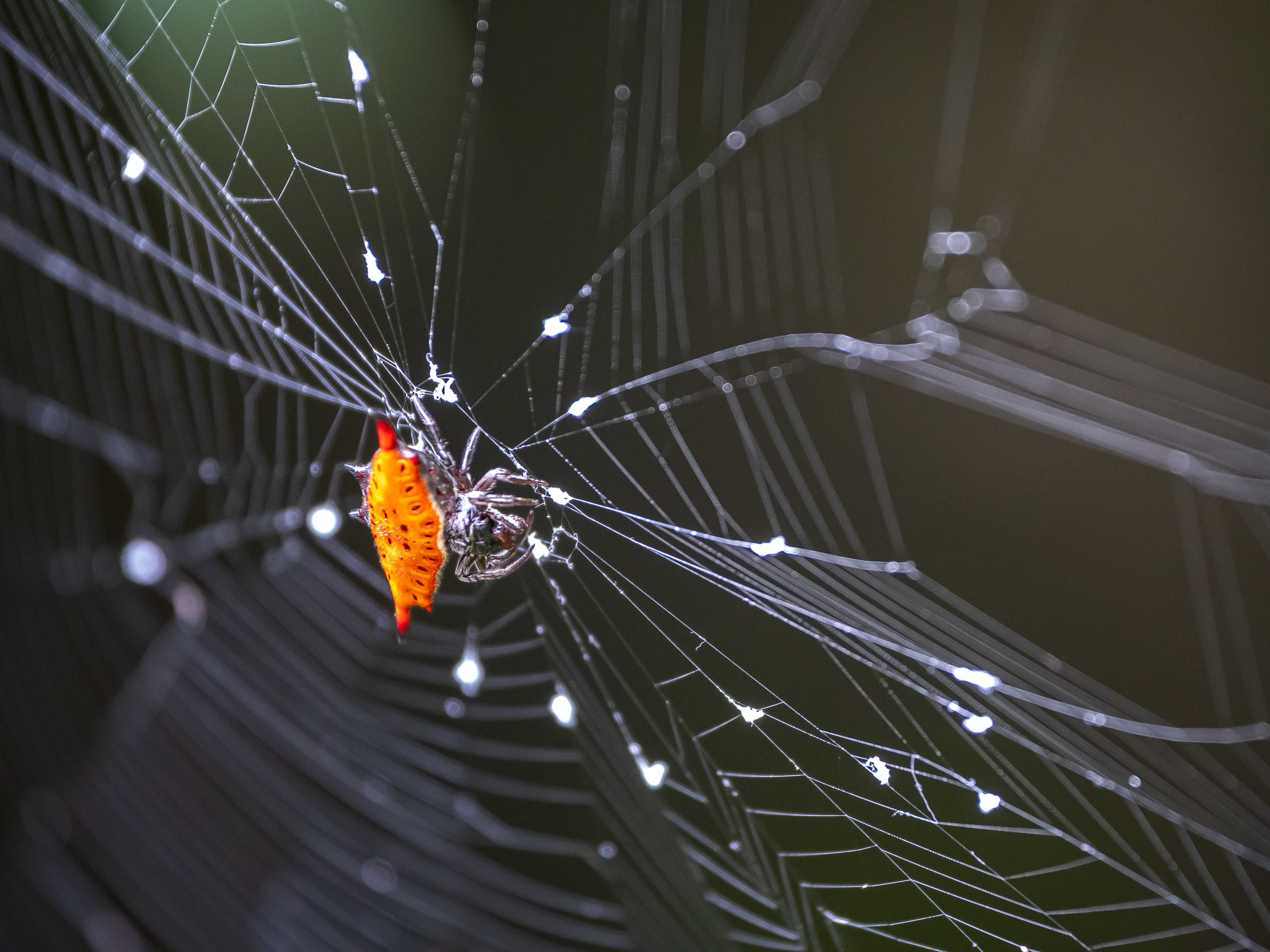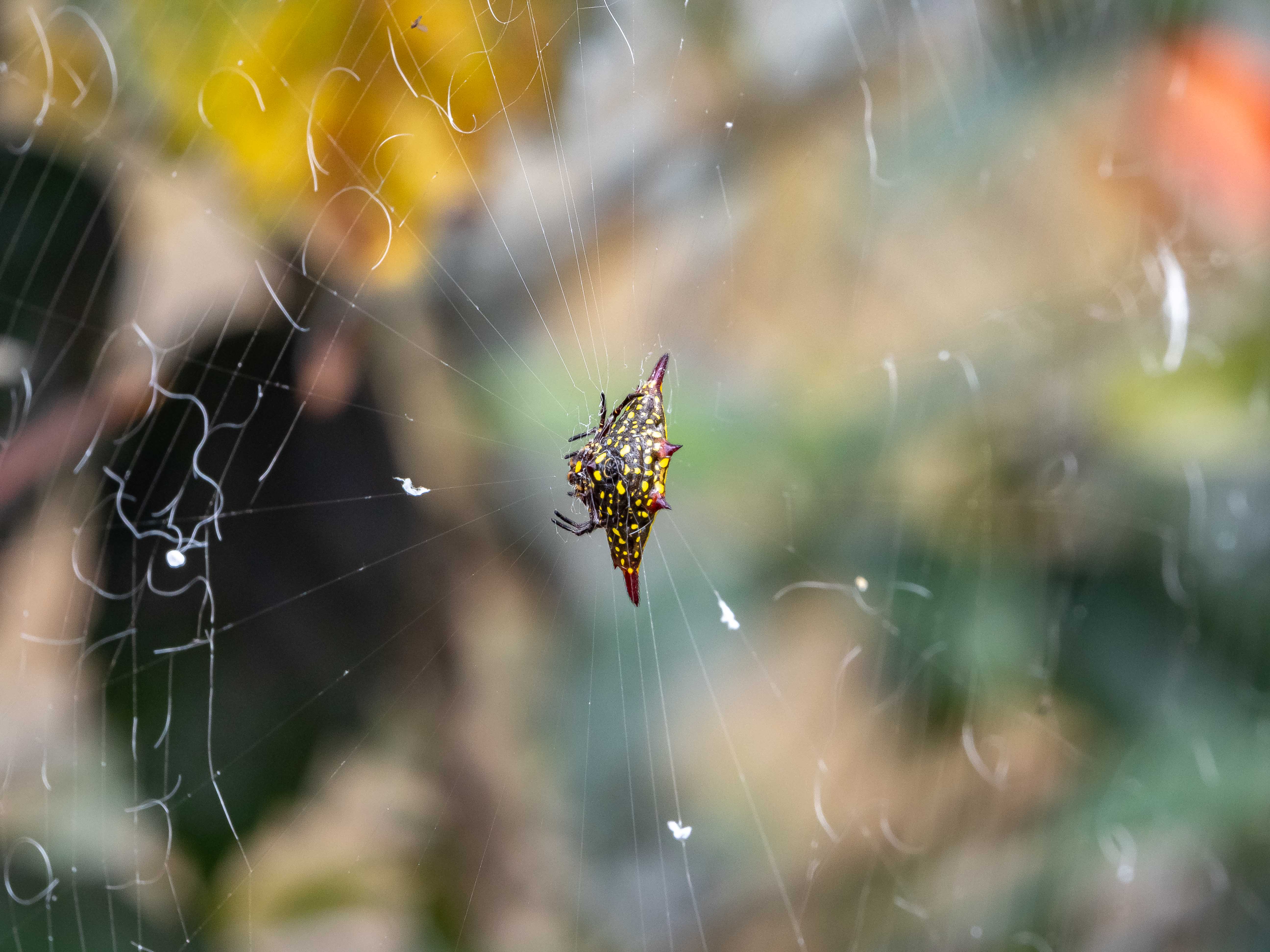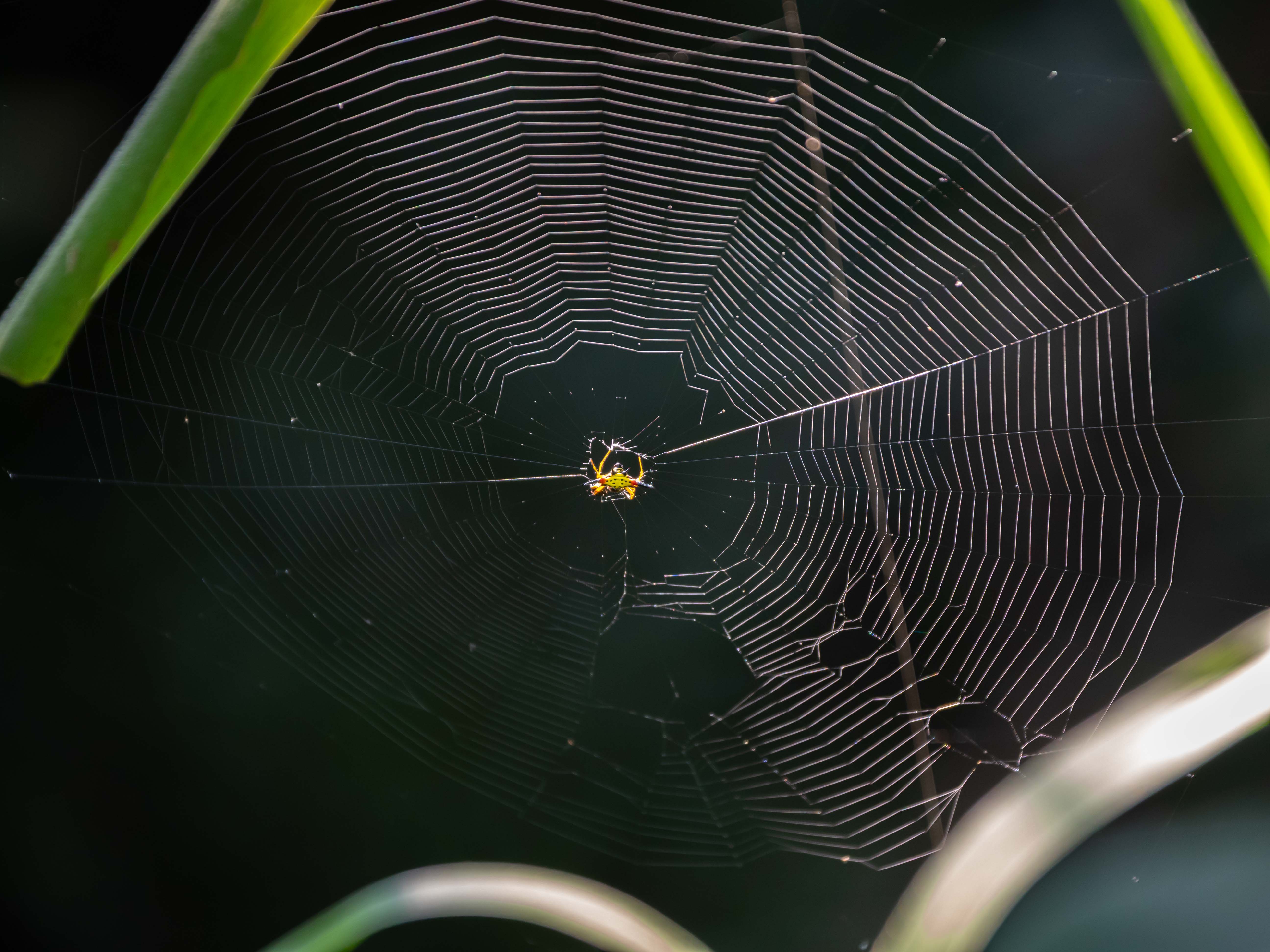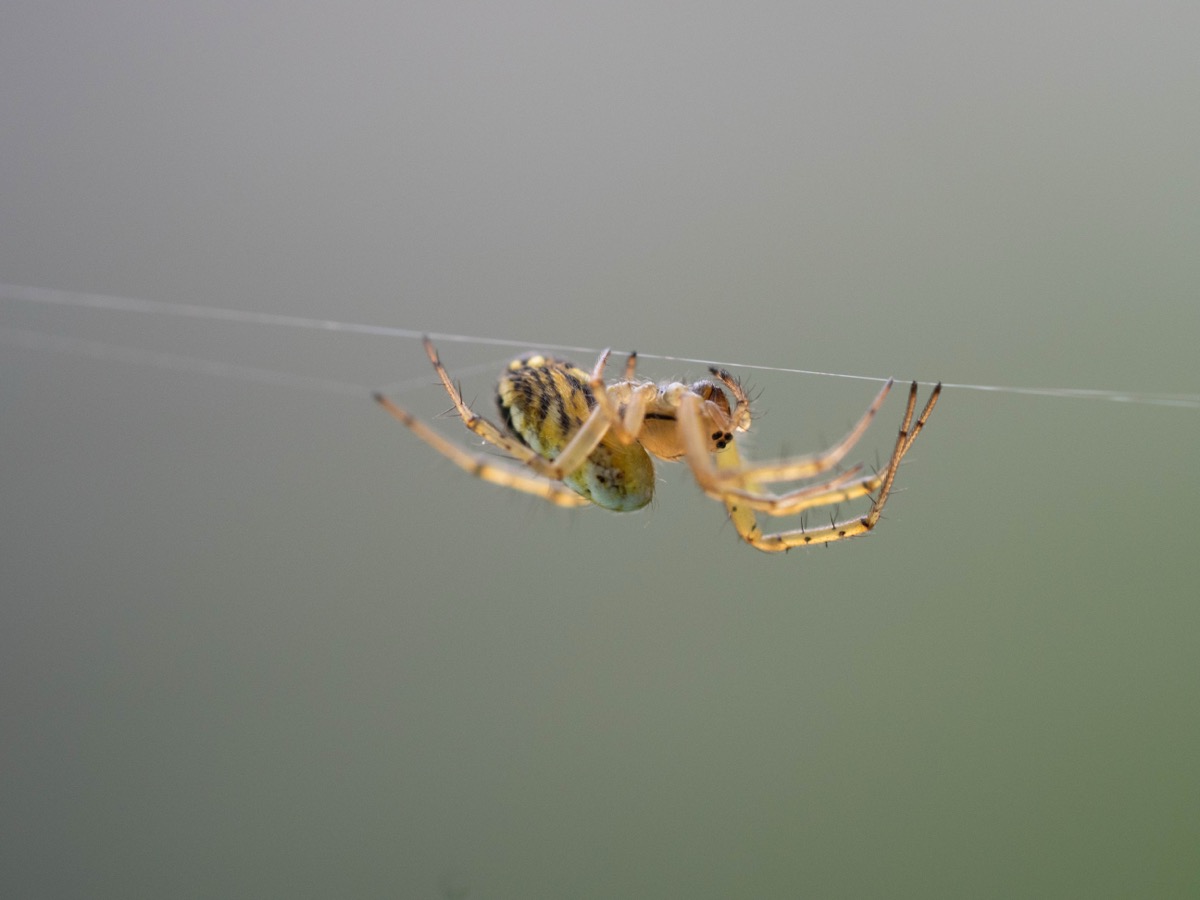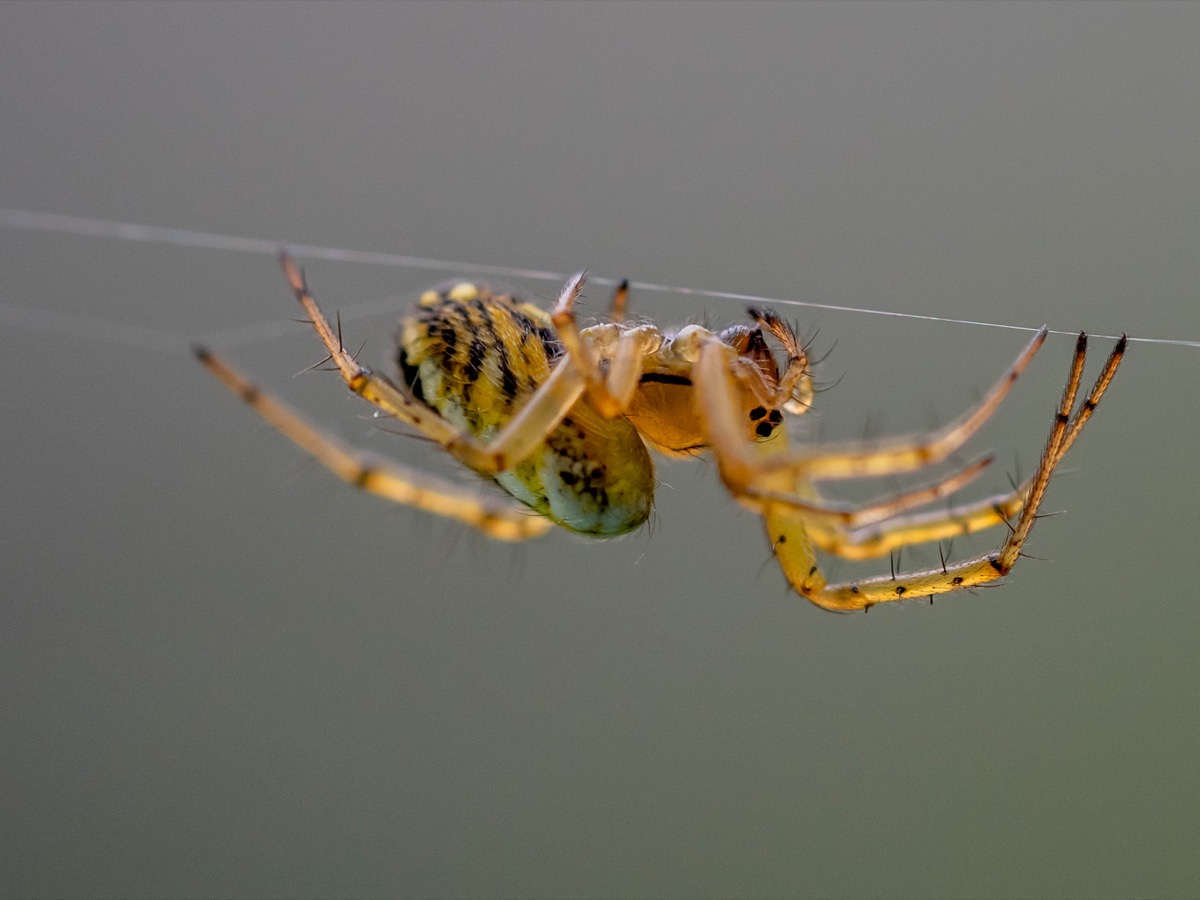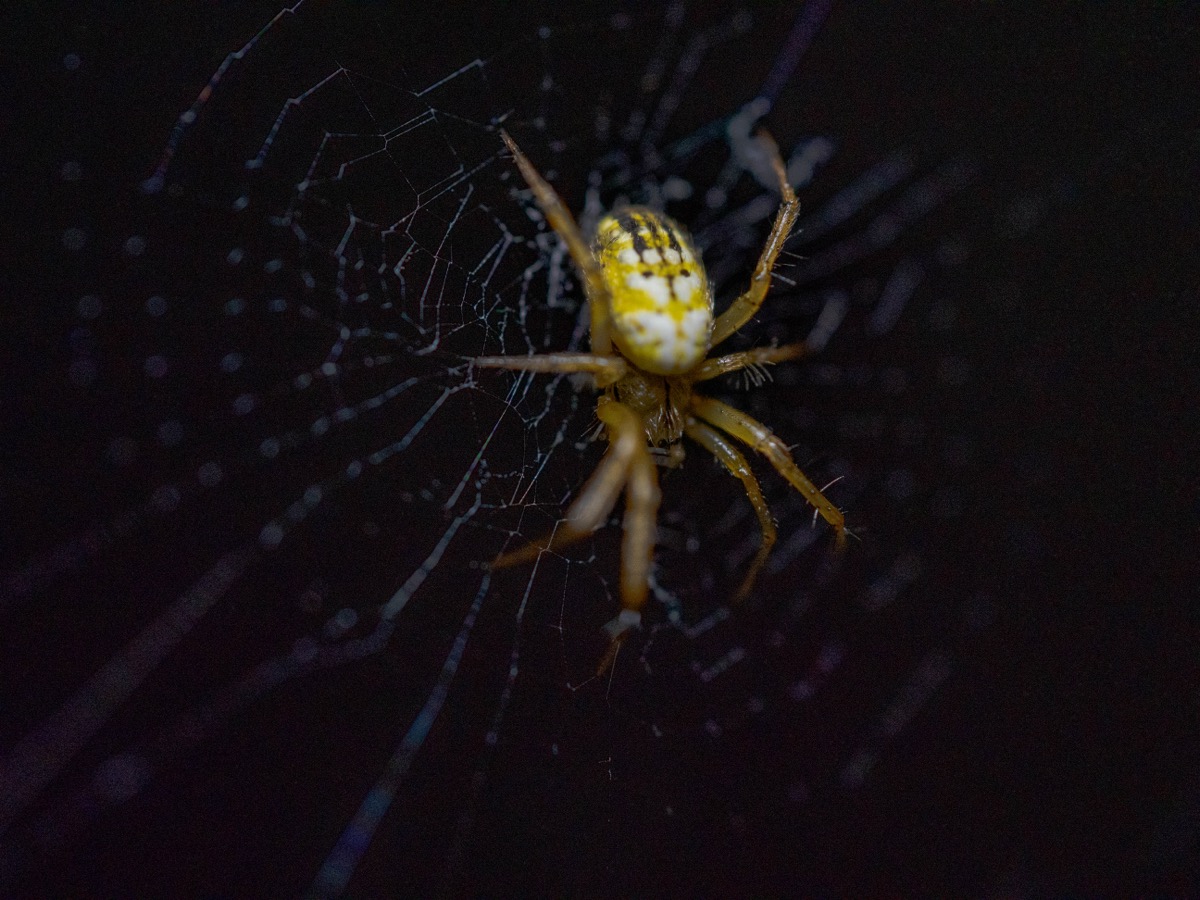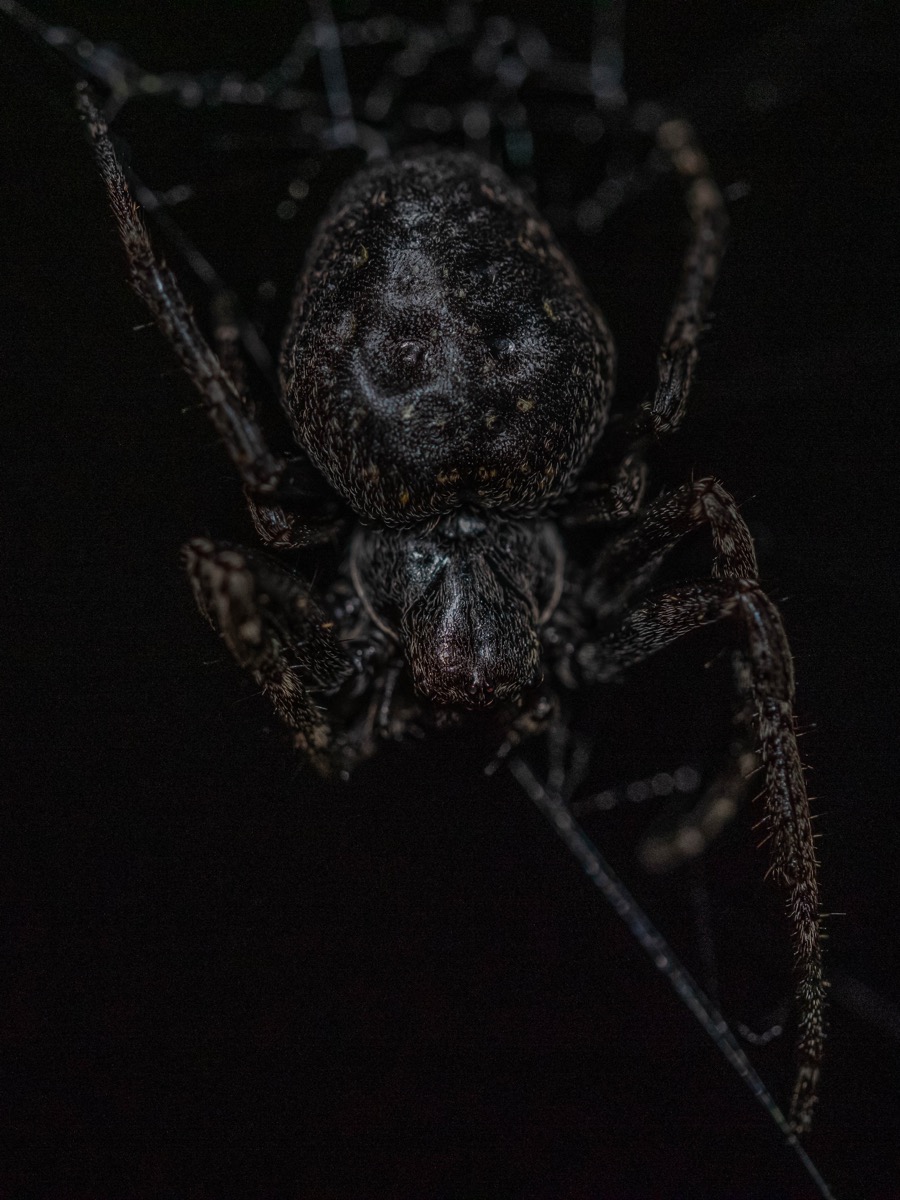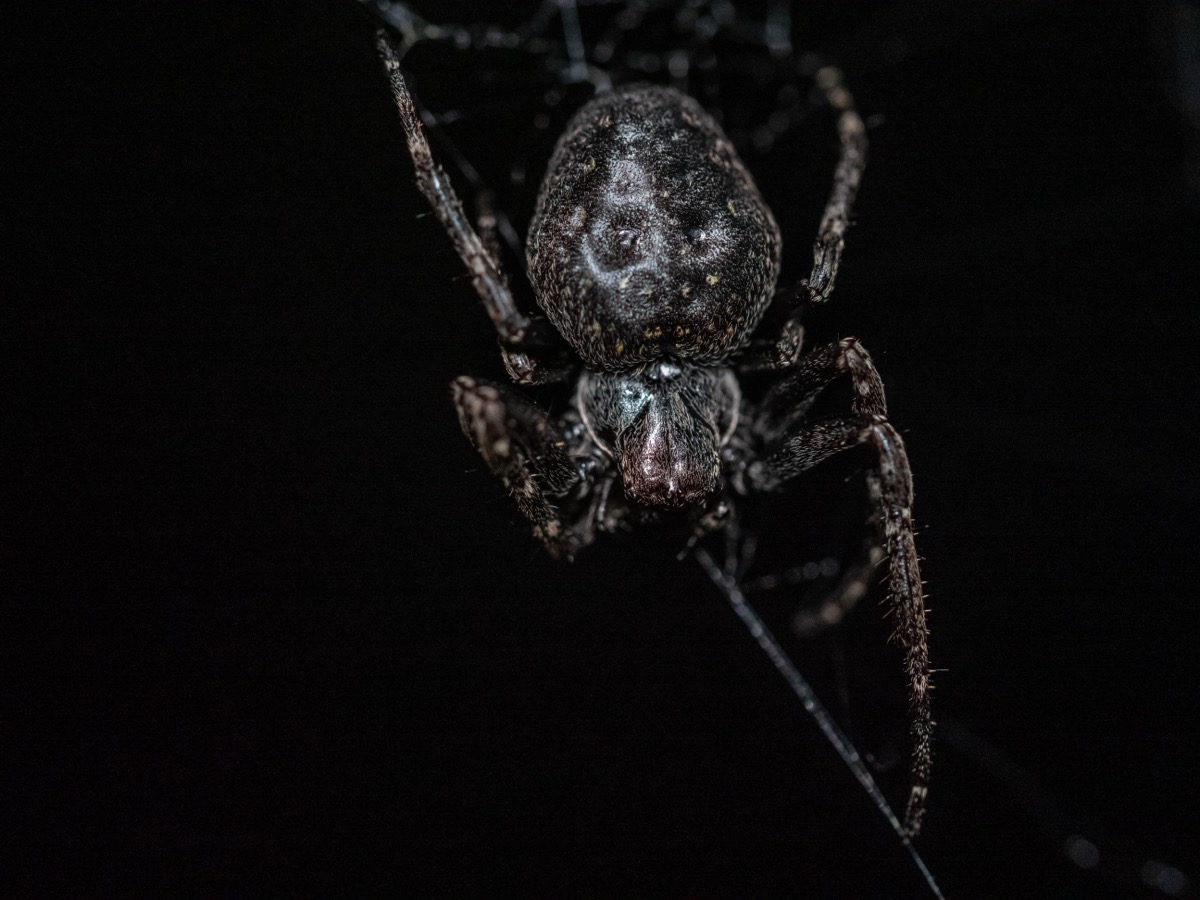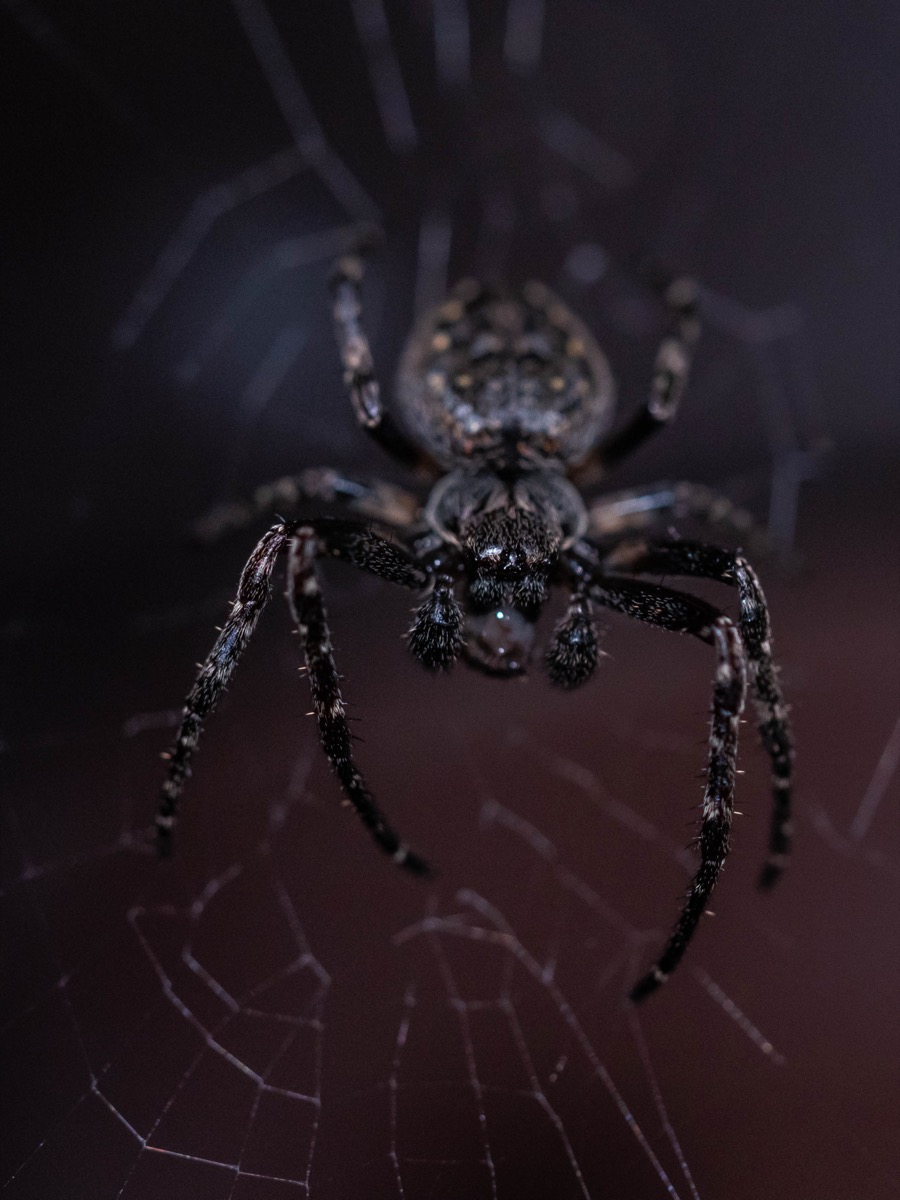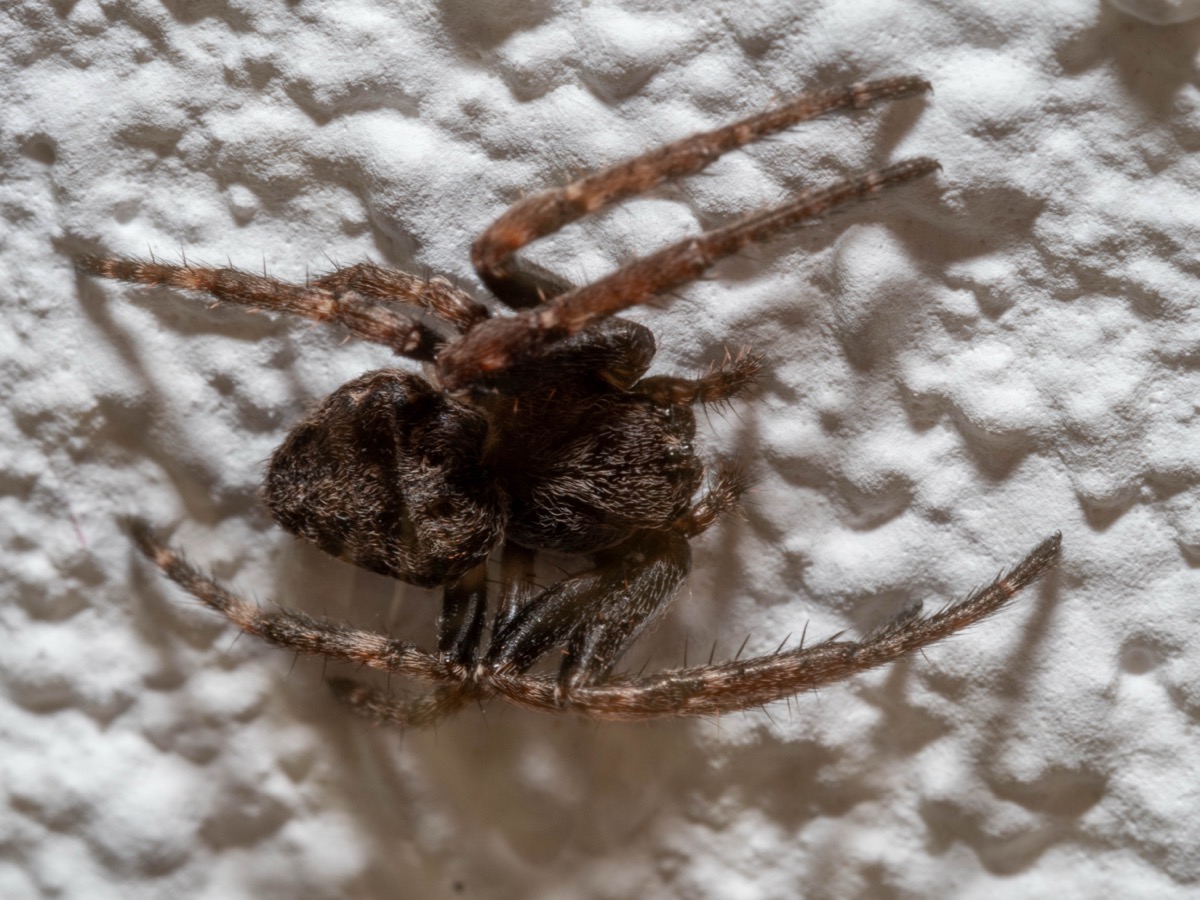The Araneidae – Orb-weaving spiders form a family that includes 178 genera. These are spiders with spiny legs that build symmetrical webs and hunt by trapping. They often have patterns on their abdomen and vary greatly in color.
They spin circular or orb-shaped webs to catch their prey. These webs are often complex and well-designed, with radial and spiral threads forming a circular structure.
Main characteristics of the Araneidae:
- Orb webs: Araneidae spiders are famous for their circular, orbit-shaped webs. They use radial threads to build the base structure, then spin spiral threads to trap prey. The spiders usually hide near the center of the web and detect the vibrations caused by trapped prey.
- Morphology: Araneidae have a wide variety of shapes, but generally possess a well-defined body, eight legs, and chelicerae for manipulating silk and prey. Their size and coloration vary, with many showing shades of brown, black, or yellow.
- Feeding behavior: Araneidae spiders are mainly insect predators. They usually wait at the center of their web, ready to catch prey entangled in the threads.
List of Araneidae genera (external link Araneae)
Genus Aculpeira
The only species of Aculpeira I have encountered is the oak spider or Aculepeira ceropegia. They are found in nature, in grasses at knee height or in shrubs. If you take the time to observe them, you’ll notice the particularly intricate pattern on their abdomen.
Aculepeira ceropegia – Oak Spider
| Order | Aranea |
|---|---|
| Family (Aranea) | Araneidae |
| Genus | Aculepeira |
| Species | Ceropegia |
| Identifier | Walckenaer |
| Year identified | 1802 |
| Male size min | 8 |
| Male size max | 8 |
| Female size min | 13 |
| Female size max | 15 |
| Color | Brown/Yellow/White |
| Prosoma/Cephalothorax | hairy grey |
| Opisthosoma/Abdomen | rugby-ball shaped – back with pale oak-leaf pattern |
| Legs (Aranea) | striped black and white |
| Spider habitat | Forest, Shrub, Pathside, Mountain |
| Web | close to the ground |
| Activity | |
| Period start | March |
| Period end | October |
| Range | Europe |
| Distinctive features | up to 3000m altitude |
References:
https://www.gbif.org/species/2159474
https://fr.wikipedia.org/wiki/Aculepeira_ceropegia
Genus Araneus
The most common Araneus you’ll come across is Araneus diadematus, the European garden spider, recognizable by the cross on its abdomen.
Araneus diadematus – European Garden Spider
| Order | Aranea |
|---|---|
| Family (Aranea) | Araneidae |
| Genus | Araneus |
| Species | Diadematus |
| Identifier | Clerck |
| Year identified | 1757 |
| Male size min | 4 |
| Male size max | 11 |
| Female size min | 10 |
| Female size max | 22.5 |
| Color | Yellow/Beige/Brown (varied) |
| Prosoma/Cephalothorax | – |
| Opisthosoma/Abdomen | back with pale cross |
| Legs (Aranea) | striped |
| Spider habitat | House/habitat, Shrub, Garden |
| Web | spiral vertical web with rays – large webs |
| Activity | |
| Period start | April |
| Period end | November |
| Range | Europe, North America, Holarctic region |
| Distinctive features | – |
References:
https://www.gbif.org/species/2160133
https://fr.wikipedia.org/wiki/Épeire_diadème
Genus Araniella
Araniella cucurbitina inhabits parks and gardens, particularly on lilacs and roses, in bushes and along forest edges.
Araniella cucurbitina - Cucumber Orb-weaver
| Order | Araneae |
|---|---|
| Family | Araneidae |
| Genus | Araniella |
| Species | cucurbitina |
| Identifier | Clerck |
| Year of identification | 1757 |
| Male size min (mm) | 3.5 |
| Male size max (mm) | 4.5 |
| Female size min (mm) | 4.5 |
| Female size max (mm) | 9.5 |
| Color | Yellow-green |
| Prosoma/Cephalothorax | Pale, translucent |
| Opisthosoma/Abdomen | Four black dots on the dorsal surface – red spot at the lower end |
| Legs | Hairy |
| Habitat | Forest, bushes, gardens |
| Web | Geometric – irregular |
| Activity | |
| Active period start | April |
| Active period end | September |
| Distribution | Palearctic region |
| Particularity | – |
The Araniella cucurbitina, or Cucumber Orb-weaver, is commonly found in hedges, bushes, rose shrubs, and forest edges, particularly on oak trees.
References:
https://www.gbif.org/fr/species/2158384
https://fr.wikipedia.org/wiki/Araniella_cucurbitina
Genus Argiope
Ah, the Argiope! An incredible spider. The first photo shows a female guarding her egg sac. She will stay there until she dies, refusing to feed in order to protect her offspring. The male is much smaller.
An important characteristic is its web. The spider rests in the center, waiting for prey. Its web features two stabilimenta, a kind of zigzag reinforcement.
Argiope appensa
| Order | Araneae |
|---|---|
| Family | Araneidae |
| Genus | Argiope |
| Species | appensa |
| Identifier | Walckenaer |
| Year of identification | 1841 |
| Male size min (mm) | 3 |
| Male size max (mm) | 5 |
| Female size min (mm) | 20 |
| Female size max (mm) | 30 |
| Color | Yellow/Black/Silvery |
| Prosoma/Cephalothorax | Covered with silvery hairs |
| Opisthosoma/Abdomen | Ovoid, bright yellow with transverse black bands; dark ventral side with two longitudinal pale stripes |
| Legs | Long, ringed with brown and black, arranged in a cross when at rest |
| Habitat | Forest edges, gardens, open tropical areas |
| Web | Vertical orb web – cross- or zigzag-shaped stabilimentum |
| Activity | Diurnal |
| Active period start | January |
| Active period end | December |
| Distribution | Southeast Asia, Western Pacific |
| Particularity | Common species on tropical islands, harmless venom to humans |
Argiope bruennichi – Wasp Spider
| Order | Araneae |
|---|---|
| Family | Araneidae |
| Genus | Argiope |
| Species | bruennichi |
| Identifier | Scopoli |
| Year of identification | 1772 |
| Male size min (mm) | 4 |
| Male size max (mm) | 6 |
| Female size min (mm) | 15 |
| Female size max (mm) | 20 |
| Color | Yellow with black bands |
| Prosoma/Cephalothorax | Pale |
| Opisthosoma/Abdomen | Symmetrical horizontal bands |
| Legs | Yellow with black rings |
| Habitat | Bushes, gardens |
| Web | Orb web – circular – stabilimentum |
| Activity | |
| Active period start | June |
| Active period end | October |
| Distribution | Palearctic region |
| Particularity | – |
References:
https://www.gbif.org/species/5170994
https://fr.wikipedia.org/wiki/Argiope_frelon
http://vosges-du-nord.fr/site/largiope-frelon-et-son-enigmatique-toile/
Informative PDF from vogelwarte.ch
Argiope reinwardti
| Order | Araneae |
|---|---|
| Family | Araneidae |
| Genus | Argiope |
| Species | reinwardti |
| Identifier | Doleschall |
| Year of identification | 1859 |
| Male size min (mm) | 2 |
| Male size max (mm) | 3 |
| Female size min (mm) | 20 |
| Female size max (mm) | 25 |
| Color | Silvery/Black/Golden |
| Prosoma/Cephalothorax | Covered with silvery hairs |
| Opisthosoma/Abdomen | Elongated, spindle-shaped, with alternating silvery and black bands; tip often pointed |
| Legs | Long, ringed with brown and black, arranged in a cross at the center of the web |
| Habitat | Open areas, forest edges, tropical gardens |
| Web | Vertical orb web – cross- or X-shaped stabilimentum |
| Activity | Diurnal |
| Active period start | January |
| Active period end | December |
| Distribution | Southeast Asia |
| Particularity | More elongated abdomen than A. appensa; harmless venom to humans |
Argiope versicolor
| Order | Araneae |
|---|---|
| Family | Araneidae |
| Genus | Argiope |
| Species | versicolor |
| Identifier | Doleschall |
| Year of identification | 1859 |
| Male size min (mm) | 3.5 |
| Male size max (mm) | 4.5 |
| Female size min (mm) | 9 |
| Female size max (mm) | 12 |
| Color | White/Yellow/Silvery/Black |
| Prosoma/Cephalothorax | Covered with silvery hairs |
| Opisthosoma/Abdomen | Rounded pentagonal shape. Dorsum with alternating bands: first purplish to carmine, followed by silvery white, yellow, and black. |
| Legs | – |
| Habitat | Forests, bushes |
| Web | Orb web – circular – stabilimentum |
| Activity | |
| Active period start | January |
| Active period end | December |
| Distribution | South Asia |
| Particularity | – |
The photo below shows an Argiope versicolor, taken in Thailand, in Khao Lak, in July 2013. Its coloration is stunning!
References:
https://www.gbif.org/fr/search?q=argiope%20versicolor
https://fr.wikipedia.org/wiki/Argiope_versicolor
http://www.dipode-vie.net/Arachnides/Araneidae/Argiope/(versicolor).html
Argiope sp
Here are a few Argiope individuals whose exact species I have not yet determined.
Genus Cyrtophora
The genus Cyrtophora belongs to the Araneidae family and is recognized by its three-dimensional, tent-shaped web, unique among orb-weaving spiders.
The females, with their angular and often green or silvery bodies, remain motionless beneath the web’s dome, where they suspend several fibrous cocoons above them.
Cyrtophora moluccensis
| Order | Araneae |
|---|---|
| Family | Araneidae |
| Genus | Cyrtophora |
| Species | moluccensis |
| Identifier | Doleschall |
| Year of identification | 1857 |
| Male size min (mm) | 6 |
| Male size max (mm) | 10 |
| Female size min (mm) | 15 |
| Female size max (mm) | 25 |
| Color | Green, yellow, black, silvery |
| Prosoma/Cephalothorax | Green to brown, darker in the center, sometimes covered with silvery hairs |
| Opisthosoma/Abdomen | Elongated and angular, often greenish-yellow with black markings; shape varies by region. Granular surface, sometimes with silvery spots. |
| Legs | Long, slender, greenish to brownish with diffuse dark bands |
| Habitat | Forests, gardens, bushes, humid tropical areas of Asia and Oceania |
| Web | Three-dimensional tent-shaped web, dense and non-sticky, with the female suspended beneath the dome; fibrous oval cocoons attached above |
Description
Cyrtophora moluccensis, also known as the Moluccan Tent-Web Spider, is an atypical orb-weaver widely distributed in Southeast Asia and the Pacific. Unlike Argiope, it does not build a flat orb web but a complex, three-dimensional structure forming a silky vault. The female hangs motionless beneath this structure in a characteristic horizontal posture.
The cocoon is suspended above the main web, often in a series of several, enveloped in coarse brownish silk. This placement protects the eggs from predators while allowing the female to keep close watch.
The abdomen is angular and variably colored — olive green, yellow, or silvery with black spots — providing excellent camouflage among vegetation. Despite its impressive appearance, this species is harmless to humans.
Behavior
- A diurnal species, usually motionless beneath the web.
- The female actively guards her cocoons suspended above.
- The web is regularly rebuilt after rain or disturbance.
- The male is much smaller and rarely seen.
Geographic distribution
Found across the Indo-Pacific region, from India and Southeast Asia to Australia. Often encountered in secondary forests, gardens, and forest edges.
Genus Gasteracantha
Gasteracantha
| Order | Araneae |
|---|---|
| Family | Araneidae |
| Genus | Gasteracantha |
| Identifier | Sundevall |
| Year of identification | 1833 |
| Male size min (mm) | 2 |
| Male size max (mm) | 4 |
| Female size min (mm) | 6 |
| Female size max (mm) | 13 |
| Color | Red, yellow, white, black |
| Prosoma/Cephalothorax | Small, brown to black, covered with fine hairs |
| Opisthosoma/Abdomen | Broad, flat, and rigid, with six spines; bright, often contrasting colors (yellow, red, white, black) |
| Legs | Short, sturdy, dark brown to black |
| Habitat | Tropical forests, gardens, forest edges, bushes |
| Web | Regular orb web; female immobile at the center, head down |
Description
Gasteracantha, or spiny orb-weavers, form a distinctive genus of Araneidae, easily recognizable by their hard, spine-studded abdomens. These spines, combined with vivid coloration — yellow, red, white, or black — serve as visual deterrents against predators.
Females are significantly larger than males, which often go unnoticed. They build regular circular webs stretched between branches and remain motionless in the center, waiting for prey.
Despite their striking appearance, these spiders are harmless to humans. Their unique morphology makes them easily identifiable and frequently photographed throughout tropical and subtropical regions of Africa, Asia, and Oceania.
Geographic distribution
Species of the Gasteracantha genus occur across tropical and subtropical regions worldwide, notably in Southeast Asia, Africa, and the Pacific Islands.
Genus Mangora
There are 186 known species in this genus. The only one found in Europe is Mangora acalypha, the Lesser Bottle Spider.
Mangora acalypha – Lesser Bottle Spider
| Order | Araneae |
|---|---|
| Family | Araneidae |
| Genus | Mangora |
| Species | acalypha |
| Identifier | Walckenaer |
| Year of identification | 1892 |
| Male size min (mm) | 3 |
| Male size max (mm) | 3.5 |
| Female size min (mm) | 5.5 |
| Female size max (mm) | 6 |
| Color | Yellow-green |
| Prosoma/Cephalothorax | Yellow-greenish to light beige |
| Opisthosoma/Abdomen | Whitish-yellow with a bottle-shaped dorsal marking |
| Legs | Pale with dark spots |
| Habitat | Bushes, sunny and dry areas, dry grasslands, path edges |
| Web | Slightly inclined horizontal orb web |
| Activity | - |
| Active period start | January |
| Active period end | December |
| Distribution | Palearctic region |
| Particularity | – |
References:
https://www.gbif.org/species/2159061
https://fr.wikipedia.org/wiki/Mangora_acalypha
Les Carnets Nature de Jessica
Genus Nuctenea
Nuctenea umbratica is the Walnut Orb-weaver (also known as the Evening Orb-weaver). It hides in cracks of buildings, trees, and wood piles.
Nuctenea umbratica – Walnut Orb-weaver
| Order | Araneae |
|---|---|
| Family | Araneidae |
| Genus | Nuctenea |
| Species | umbratica |
| Identifier | Clerck |
| Year of identification | 1757 |
| Male size min (mm) | 7.5 |
| Male size max (mm) | 8.5 |
| Female size min (mm) | 12 |
| Female size max (mm) | 16 |
| Color | Dark brown to black |
| Prosoma/Cephalothorax | – |
| Opisthosoma/Abdomen | Edge marked with pale spots – three pairs of dorsal depressions – ventral side with two symmetrical yellowish patches |
| Legs | – |
| Habitat | Houses/buildings, rocks, forests |
| Web | Orb web – oval – vertical |
| Activity | Nocturnal |
| Active period start | January |
| Active period end | December |
| Distribution | Europe |
| Particularity | – |
References:
https://www.gbif.org/species/2158999
https://fr.wikipedia.org/wiki/Nuctenea_umbratica
https://wsc.nmbe.ch/species/4966

